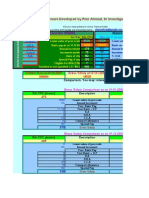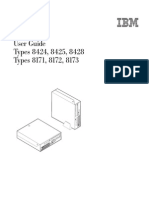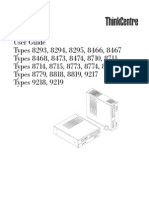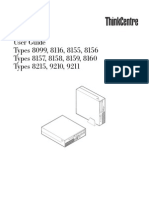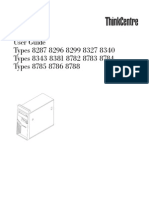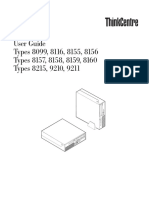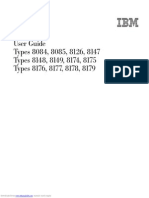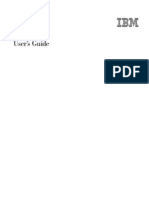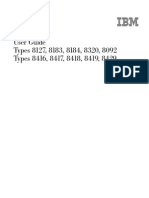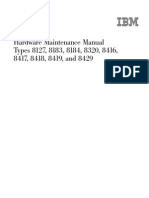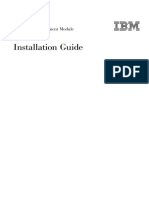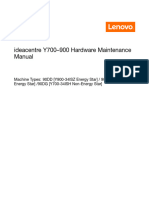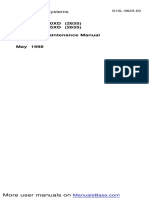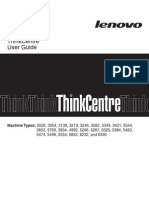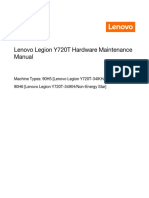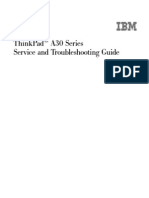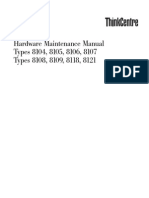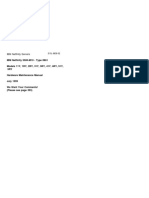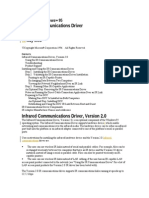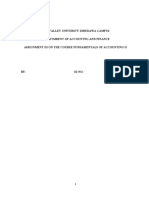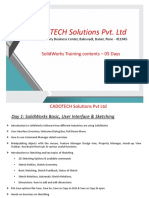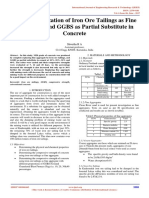Desktop User Guide
Desktop User Guide
Uploaded by
dannysionCopyright:
Available Formats
Desktop User Guide
Desktop User Guide
Uploaded by
dannysionCopyright
Available Formats
Share this document
Did you find this document useful?
Is this content inappropriate?
Copyright:
Available Formats
Desktop User Guide
Desktop User Guide
Uploaded by
dannysionCopyright:
Available Formats
ThinkCentre
User
Guide
Types
8141,
8142,
8145
Types
8420,
8421,
8426
ThinkCentre
ThinkCentre
User
Guide
Types
8141,
8142,
8145
Types
8420,
8421,
8426
Note
Before
using
this
information
and
the
product
it
supports,
be
sure
to
read
the
Important
safety
information
on
page
v
and
Appendix
D,
Notices,
on
page
41.
Second
Edition
(May
2004)
Copyright
International
Business
Machines
Corporation
2004.
All
rights
reserved.
US
Government
Users
Restricted
Rights
Use,
duplication
or
disclosure
restricted
by
GSA
ADP
Schedule
Contract
with
IBM
Corp.
Contents
Important
safety
information
.
.
.
.
.
. v
Conditions
that
require
immediate
action
.
.
.
.
. v
General
safety
guidelines
.
.
.
.
.
.
.
.
.
. vi
Service
.
.
.
.
.
.
.
.
.
.
.
.
.
.
. vi
Power
cords
and
power
adapters
.
.
.
.
.
. vi
Extension
cords
and
related
devices
.
.
.
.
. vii
Plugs
and
outlets
.
.
.
.
.
.
.
.
.
.
. vii
Batteries
.
.
.
.
.
.
.
.
.
.
.
.
.
. vii
Heat
and
product
ventilation
.
.
.
.
.
.
. viii
CD
and
DVD
drive
safety
.
.
.
.
.
.
.
. viii
Additional
safety
information
.
.
.
.
.
.
.
. ix
Lithium
battery
notice
.
.
.
.
.
.
.
.
.
.
. x
Modem
safety
information
.
.
.
.
.
.
.
.
.
. x
Laser
compliance
statement
.
.
.
.
.
.
.
.
. xi
Overview
.
.
.
.
.
.
.
.
.
.
.
.
. xiii
Information
resources
.
.
.
.
.
.
.
.
.
.
. xiii
Chapter
1.
Installing
options
.
.
.
.
.
. 1
Features
.
.
.
.
.
.
.
.
.
.
.
.
.
.
.
. 1
Specifications
.
.
.
.
.
.
.
.
.
.
.
.
.
. 4
Available
options
.
.
.
.
.
.
.
.
.
.
.
.
. 5
Tools
required
.
.
.
.
.
.
.
.
.
.
.
.
.
. 5
Handling
static-sensitive
devices
.
.
.
.
.
.
.
. 5
Installing
external
options
.
.
.
.
.
.
.
.
.
. 6
Locating
the
connectors
on
the
front
of
your
computer
.
.
.
.
.
.
.
.
.
.
.
.
.
. 7
Locating
the
connectors
on
the
rear
of
your
computer
.
.
.
.
.
.
.
.
.
.
.
.
.
. 8
Obtaining
device
drivers
.
.
.
.
.
.
.
.
. 9
Removing
the
cover
.
.
.
.
.
.
.
.
.
.
. 10
Locating
components
.
.
.
.
.
.
.
.
.
.
. 11
Identifying
parts
on
the
system
board
.
.
.
.
. 11
Installing
memory
.
.
.
.
.
.
.
.
.
.
.
. 12
Installing
adapters
.
.
.
.
.
.
.
.
.
.
.
. 14
Installing
internal
drives
.
.
.
.
.
.
.
.
.
. 16
Drive
specifications
.
.
.
.
.
.
.
.
.
.
. 16
Installing
a
drive
.
.
.
.
.
.
.
.
.
.
. 17
Installing
security
features
.
.
.
.
.
.
.
.
. 20
Identifying
security
locks
.
.
.
.
.
.
.
.
. 20
Padlock
loop
.
.
.
.
.
.
.
.
.
.
.
.
. 21
Integrated
cable
lock
.
.
.
.
.
.
.
.
.
. 22
Password
protection
.
.
.
.
.
.
.
.
.
. 22
Changing
the
battery
.
.
.
.
.
.
.
.
.
.
. 22
Erasing
a
lost
or
forgotten
password
(clearing
CMOS)
.
.
.
.
.
.
.
.
.
.
.
.
.
.
.
. 23
Replacing
the
cover
and
connecting
the
cables
.
.
. 24
Chapter
2.
Using
the
IBM
Setup
Utility
program
.
.
.
.
.
.
.
.
.
.
.
.
.
. 25
Starting
the
IBM
Setup
Utility
program
.
.
.
.
. 25
Viewing
and
changing
settings
.
.
.
.
.
.
.
. 25
Using
passwords
.
.
.
.
.
.
.
.
.
.
.
. 25
Password
considerations
.
.
.
.
.
.
.
.
. 25
User
password
.
.
.
.
.
.
.
.
.
.
.
. 26
Administrator
password
.
.
.
.
.
.
.
.
. 26
IDE
Drive
User
Password
.
.
.
.
.
.
.
. 26
IDE
Drive
Master
Password
.
.
.
.
.
.
.
. 26
Setting,
changing,
and
deleting
a
password
.
.
. 27
Using
Security
Profile
by
Device
.
.
.
.
.
.
. 27
Selecting
a
startup
device
.
.
.
.
.
.
.
.
.
. 27
Selecting
a
temporary
startup
device
.
.
.
.
. 28
Changing
the
startup
sequence
.
.
.
.
.
.
. 28
Exiting
from
the
IBM
Setup
Utility
program
.
.
. 28
Appendix
A.
Updating
system
programs
.
.
.
.
.
.
.
.
.
.
.
.
. 29
System
programs
.
.
.
.
.
.
.
.
.
.
.
. 29
Updating
(flashing)
BIOS
from
a
diskette
.
.
. 29
Updating
(flashing)
BIOS
from
your
operating
system
.
.
.
.
.
.
.
.
.
.
.
.
.
.
. 29
Recovering
from
a
POST/BIOS
update
failure
.
.
. 30
Appendix
B.
Cleaning
the
mouse
.
.
. 31
Cleaning
an
optical
mouse
.
.
.
.
.
.
.
.
. 31
Cleaning
a
mouse
with
a
ball
.
.
.
.
.
.
.
. 31
Appendix
C.
Manual
modem
commands
.
.
.
.
.
.
.
.
.
.
.
.
. 33
Basic
AT
commands
.
.
.
.
.
.
.
.
.
.
. 33
Extended
AT
commands
.
.
.
.
.
.
.
.
.
. 35
MNP/V.42/V.42bis/V.44
commands
.
.
.
.
.
. 36
Fax
Class
1
commands
.
.
.
.
.
.
.
.
.
. 37
Fax
Class
2
commands
.
.
.
.
.
.
.
.
.
. 37
Voice
commands
.
.
.
.
.
.
.
.
.
.
.
.
. 38
Appendix
D.
Notices
.
.
.
.
.
.
.
.
. 41
Television
output
notice
.
.
.
.
.
.
.
.
.
. 42
Trademarks
.
.
.
.
.
.
.
.
.
.
.
.
.
. 42
Index
.
.
.
.
.
.
.
.
.
.
.
.
.
.
. 43
Copyright
IBM
Corp.
2004
iii
iv
User
Guide
Important
safety
information
This
information
can
help
you
safely
use
your
IBM
personal
computer.
Follow
and
retain
all
information
included
with
your
IBM
computer.
The
information
in
this
document
does
not
alter
the
terms
of
your
purchase
agreement
or
the
IBM
Statement
of
Limited
Warranty.
Customer
safety
is
important
to
IBM.
Our
products
are
developed
to
be
safe
and
effective.
However,
personal
computers
are
electronic
devices.
Power
cords,
power
adapters,
and
other
features
can
create
potential
safety
risks
that
can
result
in
physical
injury
or
property
damage,
especially
if
misused.
To
reduce
these
risks,
follow
the
instructions
included
with
your
product,
observe
all
warnings
on
the
product
and
in
the
operating
instructions,
and
review
the
information
included
in
this
document
carefully.
By
carefully
following
the
information
contained
in
this
document
and
provided
with
your
product,
you
can
help
protect
yourself
from
hazards
and
create
a
safer
computer
work
environment.
Note:
This
information
includes
references
to
power
adapters
and
batteries.
In
addition
to
mobile
personal
computers,
IBM
ships
some
products
(such
as
speakers
or
monitors)
with
external
power
adapters.
If
you
have
such
a
product,
this
information
applies
to
your
product.
In
addition,
your
computer
product
may
contain
a
coin-sized
internal
battery
that
provides
power
to
your
system
clock
even
when
the
machine
is
unplugged,
so
the
battery
safety
information
applies
to
all
computers.
Conditions
that
require
immediate
action
Products
can
become
damaged
due
to
misuse
or
neglect.
Some
product
damage
is
serious
enough
that
the
product
should
not
be
used
again
until
it
has
been
inspected
and,
if
necessary,
repaired
by
an
authorized
servicer.
As
with
any
electronic
device,
pay
close
attention
to
the
product
when
it
is
turned
on.
On
very
rare
occasions,
you
might
notice
an
odor
or
see
a
puff
of
smoke
or
sparks
vent
from
your
machine.
Or
you
might
hear
sounds
like
popping,
cracking
or
hissing.
These
conditions
might
merely
mean
that
an
internal
electronic
component
has
failed
in
a
safe
and
controlled
manner.
Or,
they
might
indicate
a
potential
safety
issue.
However,
do
not
take
risks
or
attempt
to
diagnose
the
situation
yourself.
Frequently
inspect
your
computer
and
its
components
for
damage
or
wear
or
signs
of
danger.
If
you
have
any
question
about
the
condition
of
a
component,
do
not
use
the
product.
Contact
the
IBM
Support
Center
or
the
product
manufacturer
for
instructions
on
how
to
inspect
the
product
and
have
it
repaired,
if
necessary.
In
the
unlikely
event
that
you
notice
any
of
the
conditions
listed
below,
or
if
you
have
any
safety
concerns
with
your
product,
stop
using
the
product
and
unplug
it
from
the
power
source
and
telecommunication
lines
until
you
can
speak
to
the
IBM
Support
Center
for
further
guidance.
v
Power
cords,
plugs,
power
adapters,
extension
cords,
surge
protectors,
or
power
supplies
that
are
cracked,
broken
or
damaged.
v
Signs
of
overheating,
smoke,
sparks
or
fire.
Copyright
IBM
Corp.
2004
v
v
Damage
to
a
battery
(such
as
cracks,
dents,
creases),
discharge
from
a
battery,
or
a
buildup
of
foreign
substances
on
the
battery.
v
A
cracking,
hissing
or
popping
sound,
or
strong
odor
that
comes
from
the
product.
v
Signs
that
liquid
has
been
spilled
or
an
object
has
fallen
onto
the
computer
product,
the
power
cord
or
power
adapter.
v
The
computer
product,
the
power
cord
or
power
adapter
has
been
exposed
to
water.
v
The
product
has
been
dropped
or
damaged
in
any
way.
v
The
product
does
not
operate
normally
when
you
follow
the
operating
instructions.
Note:
If
you
notice
these
conditions
with
a
non-IBM
product
(such
as
an
extension
cord),
stop
using
that
product
until
you
can
contact
the
product
manufacturer
for
further
instructions,
or
until
you
get
a
suitable
replacement.
General
safety
guidelines
Always
observe
the
following
precautions
to
reduce
the
risk
of
injury
and
property
damage.
Service
Do
not
attempt
to
service
a
product
yourself
unless
instructed
to
do
so
by
the
IBM
Support
Center.
Use
only
an
IBM
authorized
service
provider
who
is
approved
to
repair
your
particular
product.
Note:
Some
parts
can
be
upgraded
or
replaced
by
the
customer.
These
parts
are
referred
to
as
Customer
Replaceable
Units,
or
CRUs.
IBM
expressly
identifies
CRUs
as
such,
and
provides
documentation
with
instructions
when
it
is
appropriate
for
customers
to
replace
those
parts.
You
must
closely
follow
all
instructions
when
performing
such
replacements.
Always
make
sure
that
the
power
is
turned
off
and
that
the
product
is
unplugged
from
any
power
source
before
you
attempt
the
replacement.
If
you
have
any
questions
or
concerns,
contact
the
IBM
Support
Center.
Power
cords
and
power
adapters
Use
only
the
power
cords
and
power
adapters
supplied
by
the
product
manufacturer.
Never
wrap
a
power
cord
around
the
power
adapter
or
other
object.
Doing
so
can
stress
the
cord
in
ways
that
can
cause
the
cord
to
fray,
crack
or
crimp.
This
can
present
a
safety
hazard.
Always
route
power
cords
so
that
they
will
not
be
walked
on,
tripped
over,
or
pinched
by
objects.
Protect
the
cord
and
power
adapters
from
liquids.
For
instance,
do
not
leave
your
cord
or
power
adapter
near
sinks,
tubs,
toilets,
or
on
floors
that
are
cleaned
with
liquid
cleansers.
Liquids
can
cause
a
short
circuit,
particularly
if
the
cord
or
power
adapter
has
been
stressed
by
misuse.
Liquids
can
also
cause
gradual
corrosion
of
the
power
cord
terminals
and/or
the
connector
terminals
on
the
adapter
which
can
eventually
result
in
overheating.
vi
User
Guide
Always
connect
power
cords
and
signal
cables
in
the
correct
order
and
ensure
that
all
power
cord
connectors
are
securely
and
completely
plugged
into
receptacles.
Do
not
use
any
power
adapter
that
shows
corrosion
at
the
ac
input
pins
and/or
shows
signs
of
overheating
(such
as
deformed
plastic)
at
the
ac
input
or
anywhere
on
the
power
adapter.
Do
not
use
any
power
cords
where
the
electrical
contacts
on
either
end
show
signs
of
corrosion
or
overheating
or
where
the
power
cord
appears
to
have
been
damaged
in
any
way.
Extension
cords
and
related
devices
Ensure
that
extension
cords,
surge
protectors,
uninterruptible
power
supplies,
and
power
strips
that
you
use
are
rated
to
handle
the
electrical
requirements
of
the
product.
Never
overload
these
devices.
If
power
strips
are
used,
the
load
should
not
exceed
the
power
strip
input
rating.
Consult
an
electrician
for
more
information
if
you
have
questions
about
power
loads,
power
requirements,
and
input
ratings.
Plugs
and
outlets
If
a
receptacle
(power
outlet)
that
you
intend
to
use
with
your
computer
equipment
appears
to
be
damaged
or
corroded,
do
not
use
the
outlet
until
it
is
replaced
by
a
qualified
electrician.
Do
not
bend
or
modify
the
plug.
If
the
plug
is
damaged,
contact
the
manufacturer
to
obtain
a
replacement.
Some
products
are
equipped
with
a
three-pronged
plug.
This
plug
fits
only
into
a
grounded
electrical
outlet.
This
is
a
safety
feature.
Do
not
defeat
this
safety
feature
by
trying
to
insert
it
into
a
non-grounded
outlet.
If
you
cannot
insert
the
plug
into
the
outlet,
contact
an
electrician
for
an
approved
outlet
adapter
or
to
replace
the
outlet
with
one
that
enables
this
safety
feature.
Never
overload
an
electrical
outlet.
The
overall
system
load
should
not
exceed
80
percent
of
the
branch
circuit
rating.
Consult
an
electrician
for
more
information
if
you
have
questions
about
power
loads
and
branch
circuit
ratings.
Be
sure
that
the
power
outlet
you
are
using
is
properly
wired,
easily
accessible,
and
located
close
to
the
equipment.
Do
not
fully
extend
power
cords
in
a
way
that
will
stress
the
cords.
Connect
and
disconnect
the
equipment
from
the
electrical
outlet
carefully
Batteries
All
IBM
personal
computers
contain
a
non-rechargeable
coin
cell
battery
to
provide
power
to
the
system
clock.
In
addition
many
mobile
products
such
as
Thinkpad
notebook
PCs
utilize
a
rechargeable
battery
pack
to
provide
system
power
when
in
portable
mode.
Batteries
supplied
by
IBM
for
use
with
your
product
have
been
tested
for
compatibility
and
should
only
be
replaced
with
IBM
approved
parts.
Never
attempt
to
open
or
service
any
battery.
Do
not
crush,
puncture,
or
incinerate
batteries
or
short
circuit
the
metal
contacts.
Do
not
expose
the
battery
to
water
or
other
liquids.
Only
recharge
the
battery
pack
strictly
according
to
instructions
included
in
the
product
documentation.
Important
safety
information
vii
Battery
abuse
or
mishandling
can
cause
the
battery
to
overheat,
which
can
cause
gasses
or
flame
to
vent
from
the
battery
pack
or
coin
cell.
If
your
battery
is
damaged,
or
if
you
notice
any
discharge
from
your
battery
or
the
buildup
of
foreign
materials
on
the
battery
leads,
stop
using
the
battery
and
obtain
a
replacement
from
the
battery
manufacturer.
Batteries
can
degrade
when
they
are
left
unused
for
long
periods
of
time.
For
some
rechargeable
batteries
(particularly
Lithium
Ion
batteries),
leaving
a
battery
unused
in
a
discharged
state
could
increase
the
risk
of
a
battery
short
circuit,
which
could
shorten
the
life
of
the
battery
and
can
also
pose
a
safety
hazard.
Do
not
let
rechargeable
Lithium-Ion
batteries
completely
discharge
or
store
these
batteries
in
a
discharged
state.
Heat
and
product
ventilation
Computers
generate
heat
when
turned
on
and
when
batteries
are
charging.
Notebook
PCs
can
generate
a
significant
amount
of
heat
due
to
their
compact
size.
Always
follow
these
basic
precautions:
v
Do
not
leave
the
base
of
your
computer
in
contact
with
your
lap
or
any
part
of
your
body
for
an
extended
period
when
the
computer
is
functioning
or
when
the
battery
is
charging.
Your
computer
produces
some
heat
during
normal
operation.
Extended
contact
with
the
body
could
cause
discomfort
or,
potentially,
a
skin
burn.
v
Do
not
operate
your
computer
or
charge
the
battery
near
flammable
materials
or
in
explosive
environments.
v
Ventilation
slots,
fans
and/or
heat
sinks
are
provided
with
the
product
for
safety,
comfort,
and
reliable
operation.
These
features
might
inadvertently
become
blocked
by
placing
the
product
on
a
bed,
sofa,
carpet,
or
other
flexible
surface.
Never
block,
cover
or
disable
these
features.
CD
and
DVD
drive
safety
CD
and
DVD
drives
spin
discs
at
a
high
speed.
If
a
CD
or
DVD
is
cracked
or
otherwise
physically
damaged,
it
is
possible
for
the
disc
to
break
apart
or
even
shatter
when
the
CD
drive
is
in
use.
To
protect
against
possible
injury
due
to
this
situation,
and
to
reduce
the
risk
of
damage
to
your
machine,
do
the
following:
v
Always
store
CD/DVD
discs
in
their
original
packaging
v
Always
store
CD/DVD
discs
out
of
direct
sunlight
and
away
from
direct
heat
sources
v
Remove
CD/DVD
discs
from
the
computer
when
not
in
use
v
Do
not
bend
or
flex
CD/DVD
discs,
or
force
them
into
the
computer
or
their
packaging
v
Check
CD/DVD
discs
for
cracks
before
each
use.
Do
not
use
cracked
or
damaged
discs
viii
User
Guide
Additional
safety
information
DANGER
Electrical
current
from
power,
telephone,
and
communication
cables
is
hazardous.
To
avoid
a
shock
hazard:
v
Do
not
connect
or
disconnect
any
cables
or
perform
installation,
maintenance,
or
reconfiguration
of
this
product
during
an
electrical
storm.
v
Connect
all
power
cords
to
a
properly
wired
and
grounded
electrical
outlet.
v
Connect
to
properly
wired
outlets
any
equipment
that
will
be
attached
to
this
product.
v
When
possible,
use
one
hand
only
to
connect
or
disconnect
signal
cables.
v
Never
turn
on
any
equipment
when
there
is
evidence
of
fire,
water,
or
structural
damage.
v
Disconnect
the
attached
power
cords,
telecommunications
systems,
networks,
and
modems
before
you
open
the
device
covers,
unless
instructed
otherwise
in
the
installation
and
configuration
procedures.
v
Connect
and
disconnect
cables
as
described
in
the
following
table
when
installing,
moving,
or
opening
covers
on
this
product
or
attached
devices.
To
connect:
1.
Turn
everything
OFF.
2.
First,
attach
all
cables
to
devices.
3.
Attach
signal
cables
to
connectors.
4.
Attach
power
cords
to
outlet.
5.
Turn
device
ON.
To
disconnect:
1.
Turn
everything
OFF.
2.
First,
remove
power
cords
from
outlet.
3.
Remove
signal
cables
from
connectors.
4.
Remove
all
cables
from
devices.
DANGER
Le
courant
lectrique
provenant
de
lalimentation,
du
tlphone
et
des
cbles
de
transmission
peut
prsenter
un
danger.
Pour
viter
tout
risque
de
choc
lectrique
:
v
Ne
manipulez
aucun
cble
et
neffectuez
aucune
opration
dinstallation,
dentretien
ou
de
reconfiguration
de
ce
produit
au
cours
dun
orage.
v
Branchez
tous
les
cordons
dalimentation
sur
un
socle
de
prise
de
courant
correctement
cbl
et
mis
la
terre.
v
Branchez
sur
des
socles
de
prise
de
courant
correctement
cbls
tout
quipement
connect
ce
produit.
v
Lorsque
cela
est
possible,
nutilisez
quune
seule
main
pour
connecter
ou
dconnecter
les
cbles
dinterface.;
v
Ne
mettez
jamais
un
quipement
sous
tension
en
cas
dincendie
ou
dinondation,
ou
en
prsence
de
dommages
matriels.
v
Avant
de
retirer
les
carters
de
lunit,
mettez
celle-ci
hors
tension
et
dconnectez
ses
cordons
dalimentation,
ainsi
que
les
cbles
qui
la
relient
aux
rseaux,
aux
systmes
de
t
lcommunication
et
aux
modems
(sauf
instruction
contraire
mentionne
dans
les
procdures
dinstallation
et
de
configuration).
Important
safety
information
ix
v
Lorsque
vous
installez,
que
vous
dplacez,
ou
que
vous
manipulez
le
prsent
produit
ou
des
priphriques
qui
lui
sont
raccords,
reportez-vous
aux
instructions
ci-dessous
pour
connecter
et
dconnecter
les
diffrents
cordons.
Connexion:
1.
Mettez
les
units
hors
tension.
2.
Commencez
par
brancher
tous
les
cordons
sur
les
units.
3.
Branchez
les
cbles
dinterface
sur
des
connecteurs.
4.
Branchez
les
cordons
dalimentation
sur
des
prises.
5.
Mettez
les
units
sous
tension.
Dconnexion:
1.
Mettez
les
units
hors
tension.
2.
Dbranchez
les
cordons
dalimentation
des
prises.
3.
Dbranchez
les
cbles
dinterface
des
connecteurs.
4.
Dbranchez
tous
les
cbles
des
units.
Lithium
battery
notice
CAUTION:
Danger
of
explosion
if
battery
is
incorrectly
replaced.
When
replacing
the
battery,
use
only
IBM
Part
Number
33F8354
or
an
equivalent
type
battery
recommended
by
the
manufacturer.
The
battery
contains
lithium
and
can
explode
if
not
properly
used,
handled,
or
disposed
of.
Do
not:
v
Throw
or
immerse
into
water
v
Heat
to
more
than
100C
(212F)
v
Repair
or
disassemble
Dispose
of
the
battery
as
required
by
local
ordinances
or
regulations.
ATTENTION
Danger
dexplosion
en
cas
de
remplacement
incorrect
de
la
batterie.
Remplacer
uniquement
par
une
batterie
IBM
de
type
ou
dun
type
quivalent
recommand
par
le
fabricant.
La
batterie
contient
du
lithium
et
peut
exploser
en
cas
de
mauvaise
utilisation,
de
mauvaise
manipulation
ou
de
mise
au
rebut
inapproprie.
Ne
pas
:
v
Lancer
ou
plonger
dans
leau
v
Chauffer
plus
de
100C
(212F)
v
Rparer
ou
dsassembler
Mettre
au
rebut
les
batteries
usages
conformment
aux
rglements
locaux.
Modem
safety
information
To
reduce
the
risk
of
fire,
electrical
shock,
or
injury
when
using
telephone
equipment,
always
follow
basic
safety
precautions,
such
as:
v
Never
install
telephone
wiring
during
a
lightning
storm.
v
Never
install
telephone
jacks
in
wet
locations
unless
the
jack
is
specifically
designed
for
wet
locations.
x
User
Guide
v
Never
touch
uninsulated
telephone
wires
or
terminals
unless
the
telephone
line
has
been
disconnected
at
the
network
interface.
v
Use
caution
when
installing
or
modifying
telephone
lines.
v
Avoid
using
a
telephone
(other
than
a
cordless
type)
during
an
electrical
storm.
There
may
be
a
remote
risk
of
electric
shock
from
lightning.
v
Do
not
use
the
telephone
to
report
a
gas
leak
in
the
vicinity
of
the
leak.
Consignes
de
scurit
relatives
au
modem
Lors
de
lutilisation
de
votre
matriel
tlphonique,
il
est
important
de
respecter
les
consignes
ci-aprs
afin
de
rduire
les
risques
dincendie,
dlectrocution
et
dautres
blessures
:
v
Ninstallez
jamais
de
cordons
tlphoniques
durant
un
orage.
v
Les
prises
tlphoniques
ne
doivent
pas
tre
installes
dans
des
endroits
humides,
except
si
le
modle
a
t
conu
cet
effet.
v
Ne
touchez
jamais
un
cordon
tlphonique
ou
un
terminal
non
isol
avant
que
la
ligne
ait
t
dconnecte
du
rseau
tlphonique.
v
Soyez
toujours
prudent
lorsque
vous
procdez
linstallation
ou
la
modification
de
lignes
tlphoniques.
v
Si
vous
devez
tlphoner
pendant
un
orage,
pour
viter
tout
risque
de
choc
lectrique,
utilisez
toujours
un
tlphone
sans
fil.
v
En
cas
de
fuite
de
gaz,
nutilisez
jamais
un
tlphone
situ
proximit
de
la
fuite.
Laser
compliance
statement
Some
IBM
Personal
Computer
models
are
equipped
from
the
factory
with
a
CD-ROM
drive
or
a
DVD-ROM
drive.
CD-ROM
drives
and
DVD-ROM
drives
are
also
sold
separately
as
options.
CD-ROM
drives
and
DVD-ROM
drives
are
laser
products.
These
drives
are
certified
in
the
U.S.
to
conform
to
the
requirements
of
the
Department
of
Health
and
Human
Services
21
Code
of
Federal
Regulations
(DHHS
21
CFR)
Subchapter
J
for
Class
1
laser
products.
Elsewhere,
these
drives
are
certified
to
conform
to
the
requirements
of
the
International
Electrotechnical
Commission
(IEC)
825
and
CENELEC
EN
60
825
for
Class
1
laser
products.
When
a
CD-ROM
drive
or
a
DVD-ROM
drive
is
installed,
note
the
following
handling
instructions.
CAUTION:
Use
of
controls
or
adjustments
or
performance
of
procedures
other
than
those
specified
herein
might
result
in
hazardous
radiation
exposure.
Removing
the
covers
of
the
CD-ROM
drive
or
DVD-ROM
drive
could
result
in
exposure
to
hazardous
laser
radiation.
There
are
no
serviceable
parts
inside
the
CD-ROM
drive
or
DVD-ROM
drive.
Do
not
remove
the
drive
covers.
Some
CD-ROM
drives
and
DVD-ROM
drives
contain
an
embedded
Class
3A
or
Class
3B
laser
diode.
Note
the
following
statement.
DANGER
Laser
radiation
when
open.
Do
not
stare
into
the
beam,
do
not
view
directly
with
optical
instruments,
and
avoid
direct
exposure
to
the
beam.
Important
safety
information
xi
DANGER:
Certains
modles
dordinateurs
personnels
sont
quips
dorigine
dune
unit
de
CD-ROM
ou
de
DVD-ROM.
Mais
ces
units
sont
galement
vendues
sparment
en
tant
quoptions.
Lunit
de
CD-ROM/DVD-ROM
est
un
appareil
laser.
Aux
tat-Unis,
lunit
de
CD-ROM/DVD-ROM
est
certifie
conforme
aux
normes
indiques
dans
le
sous-chapitre
J
du
DHHS
21
CFR
relatif
aux
produits
laser
de
classe
1.
Dans
les
autres
pays,
elle
est
certifie
tre
un
produit
laser
de
classe
1
conforme
aux
normes
CEI
825
et
CENELEC
EN
60
825.
Lorsquune
unit
de
CD-ROM/DVD-ROM
est
installe,
tenez
compte
des
remarques
suivantes:
ATTENTION:
Pour
viter
tout
risque
dexposition
au
rayon
laser,
respectez
les
consignes
de
rglage
et
dutilisation
des
commandes,
ainsi
que
les
procdures
dcrites.
Louverture
de
lunit
de
CD-ROM/DVD-ROM
peut
entraner
un
risque
dexposition
au
rayon
laser.
Pour
toute
intervention,
faites
appel
du
personnel
qualifi.
Certaines
units
de
CD-ROM/DVD-ROM
peuvent
contenir
une
diode
laser
de
classe
3A
ou
3B.
Tenez
compte
de
la
consigne
qui
suit:
DANGER
Rayonnement
laser
lorsque
le
carter
est
ouvert.
vitez
toute
exposition
directe
des
yeux
au
rayon
laser.
vitez
de
regarder
fixement
le
faisceau
ou
de
lobserver
laide
dinstruments
optiques.
xii
User
Guide
Overview
Thank
you
for
selecting
an
IBM
computer.
Your
computer
incorporates
many
of
the
latest
advances
in
computer
technology
and
can
be
upgraded
as
your
needs
change.
Adding
hardware
options
to
your
computer
is
an
easy
way
to
increase
its
capabilities.
Instructions
for
installing
external
and
internal
options
are
included
in
this
publication.
When
adding
an
option,
use
these
instructions
along
with
the
instructions
that
come
along
with
the
option.
Information
resources
The
Quick
Reference
that
comes
with
your
computer
provides
information
for
installing
your
computer
and
starting
the
operating
system.
It
also
includes
basic
troubleshooting
information,
software
recovery
procedures,
help
and
service
information,
and
warranty
information.
Access
IBM,
on
your
desktop,
provides
a
link
to
more
information
about
your
computer.
If
you
have
Internet
access,
the
most
up-to-date
manuals
for
your
computer
are
available
from
the
World
Wide
Web.
To
access
this
information,
point
your
browser
to
http://www.ibm.com/pc/support
Type
your
machine
type
and
model
number
in
the
Quick
Path
field,
and
click
Go.
Copyright
IBM
Corp.
2004
xiii
xiv
User
Guide
Chapter
1.
Installing
options
ThinkCentre
This
chapter
provides
an
introduction
to
the
features
and
options
that
are
available
for
your
computer.
You
can
expand
the
capabilities
of
your
computer
by
adding
memory,
adapters,
or
drives.
When
installing
an
option,
use
these
instructions
along
with
the
instructions
that
come
with
the
option.
Important
Before
you
install
or
remove
any
option,
read
Important
safety
information
on
page
v.
These
precautions
and
guidelines
will
help
you
work
safely.
Features
This
section
provides
an
overview
of
the
computer
features
and
preinstalled
software.
System
information
The
following
information
covers
a
variety
of
models.
For
information
for
your
specific
model,
use
the
IBM
Setup
Utility.
See
Chapter
2,
Using
the
IBM
Setup
Utility
program,
on
page
25.
Microprocessor
(varies
by
model
type)
v
Intel
Pentium
4
processor
with
HyperThreading
Technology
v
Intel
Pentium
4
processor
v
Intel
Celeron
processor
v
Internal
cache
(size
varies
by
model
type)
Memory
v
Support
for
four
double
data
rate
(DDR)
dual
inline
memory
modules
(DIMMs)
v
512
KB
flash
memory
for
system
programs
Copyright
IBM
Corp.
2004
1
Internal
drives
v
3.5-inch,
1.44
MB
diskette
drive
v
Serial
Advanced
Technology
Attachment
(SATA)
internal
hard
disk
drive
v
EIDE
CD
drive
or
DVD
drive
(some
models)
Video
subsystem
v
An
integrated
graphics
controller
for
a
Video
Graphics
Array
(VGA)
monitor
v
PCI
Express
(x16)
graphics
slot
on
the
system
board
Audio
subsystem
v
AC97
with
ADI
1981B
Audio
Codec
v
Line
in
and
line
out
connectors
on
the
rear
panel
v
Microphone
and
headphone
connectors
on
the
front
panel
Connectivity
v
10/100/1000
Mbps
integrated
Broadcom
Ethernet
controller
v
Peripheral
Component
Interconnect
(PCI)
V.90
Data/Fax
modem
(some
models)
System
management
features
v
Remote
Program
Load
(RPL)
and
Dynamic
Host
Configuration
Protocol
(DHCP)
v
Wake
on
LAN
v
Wake
on
Ring
(in
the
IBM
Setup
Utility
program,
this
feature
is
called
Serial
Port
Ring
Detect
for
an
external
modem)
v
Remote
Administration
v
Automatic
power-on
startup
v
System
Management
(SM)
BIOS
and
SM
software
v
Ability
to
store
POST
hardware
test
results
Input/output
features
v
25-pin,
Extended
Capabilities
Port
(ECP)/Extended
Parallel
Port
(EPP)
v
Two
9-pin
serial
connectors
(some
models)
v
Eight
4-pin,
USB
connectors
(two
on
front
panel
and
six
on
rear
panel)
v
PS/2
mouse
connector
v
PS/2
keyboard
connector
v
Ethernet
connector
v
VGA
monitor
connector
v
Two
rear
panel
audio
connectors
(line
in
and
line
out)
v
Two
front
panel
audio
connectors
(headphone
and
microphone)
v
IEEE
1394
connector
(some
models)
Expansion
v
Four
drive
bays
v
Two
32-bit
peripheral
component
interconnect
(PCI)
adapter
slots
v
One
PCI
Express
(x1)
adapter
slot
v
One
PCI
Express
(x16)
graphics
adapter
slot
2
User
Guide
Power
v
310
W
power
supply
with
manual
voltage
selection
switch
v
Automatic
50/60
Hz
input
frequency
switching
v
Advanced
Power
Management
support
v
Advanced
Configuration
and
Power
Interface
(ACPI)
support
Security
features
v
User
and
administrator
passwords
v
User
and
master
passwords
for
hard
disk
drive
(some
models)
v
Support
for
the
addition
of
a
padlock
v
Support
for
the
addition
of
an
integrated
cable
lock
v
Cover
presence
switch
v
Startup
sequence
control
v
Startup
without
diskette
drive,
keyboard,
or
mouse
v
Unattended
start
mode
v
Diskette
and
hard
disk
I/O
control
v
Serial
and
parallel
port
I/O
control
v
Security
profile
by
device
IBM
preinstalled
software
Your
computer
might
come
with
preinstalled
software.
If
it
does,
an
operating
system,
device
drivers
to
support
built-in
features,
and
other
support
programs
are
included.
Operating
systems
(preinstalled)
(varies
by
model
type)
Note:
Not
all
countries
or
regions
will
have
these
operating
systems.
v
Microsoft
Windows
XP
Home
v
Microsoft
Windows
XP
Professional
Operating
systems
(certified
or
tested
for
compatibility)
1
Linux
1. The
operating
systems
listed
here
are
being
certified
or
tested
for
compatibility
at
the
time
this
publication
goes
to
press.
Additional
operating
systems
might
be
identified
by
IBM
as
compatible
with
your
computer
following
the
publication
of
this
booklet.
Corrections
and
additions
to
this
list
are
subject
to
change.
To
determine
if
an
operating
system
has
been
certified
or
tested
for
compatibility,
check
the
Web
site
of
the
operating
system
vendor.
Chapter
1.
Installing
options
3
Specifications
This
section
lists
the
physical
specifications
for
your
computer.
Dimensions
Height:
146
mm
(5.7
in.)
Width:
442
mm
(17.4
in.)
Depth:
401
mm
(15.8
in)
Weight
Minimum
configuration
as
shipped:
24
lb
(11
kg)
Maximum
configuration:
31
lb
(14
kg)
Environment
Air
temperature:
System
on:
10
to
35C
(50
to
95
F)
System
off:
10
to
43C
(50
to
110
F)
Maximum
altitude:
2134
m
(7000
ft)
Note:
The
maximum
altitude,
2134
m
(7000
ft),
is
the
maximum
altitude
at
which
the
specified
air
temperatures
apply.
At
higher
altitudes,
the
maximum
air
temperatures
are
lower
than
those
specified.
Humidity:
System
on:
8%
to
80%
System
off:
8%
to
80%
Electrical
input
Input
voltage:
Low
range:
Minimum:
90
V
ac
Maximum:
180
V
ac
Input
frequency
range:
4753
Hz
Voltage
switch
setting:
115
V
ac
High
range:
Minimum:
137
V
ac
Maximum:
265
V
ac
Input
frequency
range:
5763
Hz
Voltage
switch
setting:
230
V
ac
Input
kilovolt-amperes
(kVA)
(approximate):
Minimum
configuration
as
shipped:
0.09
kVA
Maximum
configuration:
0.32
kVA
Note:
Power
consumption
and
heat
output
vary
depending
on
the
number
and
type
of
optional
features
installed
and
the
power-management
optional
features
in
use.
Heat
output
(approximate)
in
British
thermal
units
(Btu)
per
hour:
Minimum
configuration:
256
Btu/hr
(75
watts)
Maximum
configuration:
1058
Btu/hr
(310
watts)
Airflow
Approximately
1.13
cubic
meters
per
minute
(40
cubic
feet
per
minute)
maximum
Acoustical
noise-emission
values
Average
sound-pressure
levels:
At
operator
position:
(0.5
meters)
Idle:
33
dBA
Operating:
35
dBA
At
bystander
position
-
1
meter
(3.3
ft):
Idle:
29
dBA
Operating:
31
dBA
Declared
(upper
limit)
sound-power
levels:
Idle:
4.3
bels
Operating:
4.4
bels
Note:
These
levels
were
measured
in
controlled
acoustical
environments
according
to
the
procedures
specified
by
the
American
National
Standards
Institute
(ANSI)
S12.10
and
ISO
7779
and
are
reported
in
accordance
with
ISO
9296.
Actual
sound-pressure
levels
in
a
given
location
might
exceed
the
average
values
stated
because
of
room
reflections
and
other
nearby
noise
sources.
The
declared
sound-power
levels
indicate
an
upper
limit,
below
which
a
large
number
of
computers
will
operate.
4
User
Guide
Available
options
The
following
are
some
available
options:
v
External
options
Parallel
port
devices,
such
as
printers
and
external
drives
Serial
port
devices,
such
as
external
modems
and
digital
cameras
Audio
devices,
such
as
external
speakers
for
the
sound
system
USB
devices,
such
as
printers,
joysticks,
and
scanners
Security
device,
such
as
a
padlock
or
integrated
cable
lock
Monitors
v
Internal
options
System
memory,
called
dual
inline
memory
modules
(DIMMs)
Peripheral
component
interconnect
(PCI)
adapters
PCI
Express
(x1)
adapter
PCI
Express
(x16)
graphics
adapter
Internal
drives,
such
as:
-
CD
drive
or
DVD
drive
(some
models)
-
Hard
disk
drive
-
Diskette
drives
and
other
removable
media
drives
For
the
latest
information
about
available
options,
see
the
following
World
Wide
Web
pages:
v
http://www.ibm.com/pc/us/options/
v
http://www.ibm.com/pc/support/
You
can
also
obtain
information
by
calling
the
following
telephone
numbers:
v
Within
the
United
States,
call
1-800-IBM-2YOU
(1-800-426-2968),
your
IBM
reseller,
or
IBM
marketing
representative.
v
Within
Canada,
call
1-800-565-3344
or
1-800-IBM-4YOU.
v
Outside
the
United
States
and
Canada,
contact
your
IBM
reseller
or
IBM
marketing
representative.
Tools
required
To
install
some
options
in
your
computer,
you
might
need
a
flat-blade
or
Phillips
screwdriver.
Additional
tools
might
be
needed
for
certain
options.
See
the
instructions
that
come
with
the
option.
Handling
static-sensitive
devices
Static
electricity,
although
harmless
to
you,
can
seriously
damage
computer
components
and
options.
When
you
add
an
option,
do
not
open
the
static-protective
package
containing
the
option
until
you
are
instructed
to
do
so.
When
you
handle
options
and
other
computer
components,
take
these
precautions
to
avoid
static
electricity
damage:
v
Limit
your
movement.
Movement
can
cause
static
electricity
to
build
up
around
you.
Chapter
1.
Installing
options
5
v
Always
handle
components
carefully.
Handle
adapters
and
memory
modules
by
the
edges.
Never
touch
any
exposed
circuitry.
v
Prevent
others
from
touching
components.
v
When
you
install
a
new
option,
touch
the
static-protective
package
containing
the
option
to
a
metal
expansion-slot
cover
or
other
unpainted
metal
surface
on
the
computer
for
at
least
two
seconds.
This
reduces
static
electricity
in
the
package
and
your
body.
v
When
possible,
remove
the
option
and
install
it
directly
in
the
computer
without
setting
the
option
down.
When
this
is
not
possible,
place
the
static-protective
package
that
the
option
came
in
on
a
smooth,
level
surface
and
place
the
option
on
it.
v
Do
not
place
the
option
on
the
computer
cover
or
other
metal
surface.
Installing
external
options
This
section
shows
the
various
external
connectors
on
your
computer
to
which
you
can
attach
external
options,
such
as
external
speakers,
a
printer,
or
a
scanner.
For
some
external
options,
you
must
install
additional
software
in
addition
to
making
the
physical
connection.
When
adding
an
external
option,
use
the
information
in
this
section
to
identify
the
required
connector,
and
then
use
the
instructions
that
come
with
the
option
to
help
you
make
the
connection
and
install
any
software
or
device
drivers
that
are
required
for
the
option.
6
User
Guide
Locating
the
connectors
on
the
front
of
your
computer
The
following
illustration
shows
the
locations
of
the
connectors
on
the
front
of
the
computer.
Note:
Not
all
computer
models
will
have
the
following
connectors.
ThinkCentre
1
3
9
4
1IEEE
1394
connector
4Microphone
connector
2USB
connector
5Headphone
connector
3USB
connector
Chapter
1.
Installing
options
7
Locating
the
connectors
on
the
rear
of
your
computer
The
following
illustration
shows
the
locations
of
the
connectors
on
the
rear
of
the
computer.
1PCI
slots
9
Diagnostic
LEDs
2PCI
Express
(x1)
slot
10Power
connector
3PCI
Express
(x16)
graphics
slot
11Audio
line
out
connector
4Ethernet
connector
12Audio
line
in
connector
5USB
connectors
13VGA
monitor
connector
6Mouse
connector
14Serial
connector
7Parallel
connector
15Keyboard
connector
8Serial
connector
(some
models)
16USB
connectors
Note:
Some
connectors
on
the
rear
of
the
computer
are
color-coded
to
help
you
to
determine
where
to
connect
the
cables
on
your
computer.
8
User
Guide
Connector
Description
Ethernet
connector
Used
to
attach
an
Ethernet
cable
for
a
local
area
network
(LAN).
Note:
To
operate
the
computer
within
FCC
Class
B
limits,
use
a
Category
5
Ethernet
cable.
USB
connectors
Used
to
attach
a
device
that
requires
a
Universal
Serial
Bus
(USB)
connection,
such
as
a
USB
scanner
or
USB
printer.
If
you
have
more
than
six
USB
devices,
you
can
purchase
a
USB
hub,
which
you
can
use
to
connect
additional
USB
devices.
Mouse
connector
Used
to
attach
a
mouse,
trackball,
or
other
pointing
device
that
uses
a
standard
mouse
connector.
Parallel
connector
Used
to
attach
a
parallel
printer,
parallel
scanner,
or
other
devices
that
use
a
25-pin
parallel
connector.
Serial
connectors
Used
to
attach
an
external
modem,
serial
printer,
or
other
devices
that
use
a
9-pin
serial
connector.
Audio
line
out
connector
Used
to
send
audio
signals
from
the
computer
to
external
devices,
such
as
powered
stereo
speakers
(speakers
with
built-in
amplifiers),
headphones,
multimedia
keyboards,
or
the
audio
line
in
connector
on
a
stereo
system
or
other
external
recording
device.
Audio
line
in
connector
Used
to
receive
audio
signals
from
an
external
audio
device,
such
as
a
stereo
system.
When
you
attach
an
external
audio
device,
a
cable
is
connected
between
the
audio
line
out
connector
of
the
device
and
the
audio
line
in
connector
of
the
computer.
Keyboard
connector
Used
to
attach
a
keyboard
that
uses
a
standard
keyboard
connector.
Obtaining
device
drivers
You
can
obtain
device
drivers
for
operating
systems
that
are
not
preinstalled
at
http://www.ibm.com/pc/support/
on
the
World
Wide
Web.
Installation
instructions
are
provided
in
README
files
with
the
device-driver
files.
Chapter
1.
Installing
options
9
Removing
the
cover
Important:
Read
Important
safety
information
on
page
v
and
Handling
static-sensitive
devices
on
page
5
before
removing
the
cover.
To
remove
the
cover:
1.
Shut
down
your
operating
system,
remove
any
media
(diskettes,
CDs,
or
tapes)
from
the
drives,
and
turn
off
all
attached
devices
and
the
computer.
2.
Unplug
all
power
cords
from
electrical
outlets.
3.
Disconnect
all
cables
attached
to
the
computer.
This
includes
power
cords,
input/output
(I/O)
cables,
and
any
other
cables
that
are
connected
to
the
computer.
4.
Press
the
buttons
on
the
sides
of
the
computer
and
pivot
the
rear
end
of
the
cover
up
toward
the
front
of
the
computer.
ThinkCentre
10
User
Guide
Locating
components
The
following
illustration
will
help
you
locate
the
various
components
in
your
computer.
* X X X X X X X X X * * X X X X X X X X X *
1Power
supply
5PCI
Express
(x16)
graphics
slot
2DIMMs
6Battery
3PCI
Express
(x1)
slot
7Microprocessor
and
heat
sink
4PCI
slot
Identifying
parts
on
the
system
board
The
system
board
(sometimes
called
the
planar
or
motherboard)
is
the
main
circuit
board
in
your
computer.
It
provides
basic
computer
functions
and
supports
a
variety
of
devices
that
are
IBM-installed
or
that
you
can
install
later.
Chapter
1.
Installing
options
11
The
following
illustration
shows
the
locations
of
parts
on
the
system
board.
1
12v
power
connector
13SATA
2
connector
2
Diskette
drive
connector
14SATA
1
connector
3
Speaker
connector
15Cover
presence
switch
connector
4
DIMM
connector
4
16Power
supply
connector
5
DIMM
connector
3
17PCI
Express
(x16)
graphics
slot
6
DIMM
connector
2
18PCI
Express
(x1)
slot
7
DIMM
connector
1
19PCI
slot
2
8
Clear
CMOS/Recovery
jumper
20PCI
slot
1
9
Front
panel
connector
21Battery
10PATA
IDE
connector
22Microprocessor
11SATA
4
connector
23Microprocessor
fan
connector
12SATA
3
connector
24Microprocessor
heat
sink
Installing
memory
Your
computer
has
four
connectors
for
installing
dual
inline
memory
modules
(DIMMs)
that
provide
up
to
a
maximum
of
4.0
GB
of
system
memory.
System
memory
is
divided
into
two
channels
(channel
A
and
B).
DIMM
connectors
1
and
2
are
channel
A,
and
DIMM
connectors
3
and
4
are
channel
B.
If
DIMMs
are
present
in
both
channels,
your
computer
operates
in
dual
channel
mode.
Your
computer
has
either
double
data
rate
(DDR)
or
double
data
rate
2
(DDR2)
memory.
The
type
of
memory
required
depends
on
the
system
board
that
is
installed
in
your
computer.
1.
Remove
the
cover.
See
Removing
the
cover
on
page
10.
2.
Locate
the
DIMM
connectors.
See
Identifying
parts
on
the
system
board
on
page
11.
12
User
Guide
v
If
the
two
DIMM
connectors
closest
to
the
edge
of
the
system
board
are
a
yellow
color,
your
system
board
has
DDR
type
memory.
DDR
DIMMs
are
184-pin,
2.5
V
and
can
be
used
in
any
combination
of
128
MB,
256
MB,
512
MB,
and
1
GB
sizes.
v
If
the
two
DIMM
connectors
closest
to
the
edge
of
the
system
board
are
a
green
color,
your
system
board
has
DDR2
type
memory.
DDR
DIMMs
are
240-pin,
1.8
V
and
can
be
used
in
any
combination
of
256
MB,
512
MB,
and
1
GB
sizes.
Note:
The
type
of
memory
required
is
also
indicated
in
text
near
the
IBM
logo
on
the
system
board.
To
install
a
DIMM:
1.
Remove
the
cover.
See
Removing
the
cover
on
page
10.
2.
You
might
have
to
remove
an
adapter
to
gain
access
to
the
DIMM
slots.
See
Installing
adapters
on
page
14.
3.
Rotate
the
drive
bay
assembly
upward
to
gain
access
to
the
system
board.
* X X X X X X X X X * * X X X X X X X X X *
4.
To
locate
the
DIMM
connectors.
See
Identifying
parts
on
the
system
board
on
page
11.
5.
Open
the
retaining
clips.
Chapter
1.
Installing
options
13
6.
Make
sure
the
notches
in
the
DIMM
align
with
the
tabs
on
the
connector.
Push
or
insert
the
DIMM
straight
down
into
the
connector
until
the
retaining
clips
close.
What
to
do
next:
v
To
work
with
another
option,
go
to
the
appropriate
section.
v
To
complete
the
installation,
go
to
Replacing
the
cover
and
connecting
the
cables
on
page
24.
Installing
adapters
This
section
provides
information
and
instructions
for
installing
and
removing
adapters.
Your
computer
has
two
expansion
slots
for
PCI
adapters,
one
PCI
Express
(x1)
adapter
slot,
and
one
PCI
Express
(x16)
graphics
adapter
slot.
You
can
install
an
adapter
up
to
340
mm
(13.4
inches)
long
in
PCI
slot
1
and
PCI
slot
2.
To
install
an
adapter:
1.
Remove
the
cover.
See
Removing
the
cover
on
page
10.
2.
Rotate
the
drive
bay
assembly
upward
to
gain
access
to
the
system
board.
* X X X X X X X X X * * X X X X X X X X X *
14
User
Guide
3.
Open
the
adapter-slot-cover
latch
and
remove
the
slot
cover
for
the
appropriate
expansion
slot.
* X X X X X X X X X * * X X X X X X X X X *
4.
Remove
the
adapter
from
its
static-protective
package.
5.
Install
the
adapter
into
the
appropriate
slot
on
the
system
board.
6.
Close
the
adapter-slot-cover
latch.
* X X X X X X X X X * * X X X X X X X X X *
What
to
do
next:
v
To
work
with
another
option,
go
to
the
appropriate
section.
v
To
complete
the
installation,
go
to
Replacing
the
cover
and
connecting
the
cables
on
page
24.
Chapter
1.
Installing
options
15
Installing
internal
drives
This
section
provides
information
and
instructions
for
installing
and
removing
internal
drives.
Internal
drives
are
devices
that
your
computer
uses
to
read
and
store
data.
You
can
add
drives
to
your
computer
to
increase
storage
capacity
and
to
enable
your
computer
to
read
other
types
of
media.
Some
of
the
different
drives
that
are
available
for
your
computer
are:
v
Serial
Advanced
Technology
Attachment
(SATA)
hard
disk
drives
v
Parallel
ATA
hard
disk
drives
v
CD
drives
or
DVD
drives
v
Tape
drives
v
Removable
media
drives
Note:
These
different
drives
are
also
referred
to
as
integrated
drive
electronics
(IDE)
drives.
Internal
drives
are
installed
in
bays.
In
this
book,
the
bays
are
referred
to
as
bay
1,
bay
2,
and
so
on.
When
you
install
an
internal
drive,
it
is
important
to
note
what
type
and
size
of
drive
that
you
can
install
in
each
bay.
Also,
it
is
important
to
correctly
connect
the
internal
drive
cables
to
the
installed
drive.
Drive
specifications
Your
computer
comes
with
the
following
IBM-installed
drives:
v
A
3.5-inch
diskette
drive
in
bay
1
v
A
CD
drive
or
DVD
drive
in
bay
2
(some
models)
v
A
3.5-inch
hard
disk
drive
in
bay
4
Any
bay
that
does
not
have
a
drive
installed
has
a
static
shield
and
bay
panel
installed.
16
User
Guide
The
following
illustration
shows
the
locations
of
the
drive
bays.
The
following
list
describes
some
of
the
drives
that
you
can
install
in
each
bay
and
their
height
requirements:
1
Bay
1
-
Maximum
height:
25.8
mm
(1.0
in.)
3.5-inch
diskette
drive
(preinstalled)
2
Bay
2
-
Maximum
height:
43.0
mm
(1.7
in.)
CD
drive
or
DVD
drive
(preinstalled
in
some
models)
5.25-inch
hard
disk
drive
3
Bay
3
-
Maximum
height:
43.0
mm
(1.7
in.)
5.25-inch
hard
disk
drive
3.5-inch
hard
disk
drive
(requires
a
mounting
bracket)
CD
drive
DVD
drive
4
Bay
4
-
Maximum
height:
25.8
mm
(1.0
in.)
3.5-inch
hard
disk
drive
(preinstalled)
Notes:
1.
Drives
that
are
greater
than
43.0
mm
(1.7
in.)
high
cannot
be
installed.
2.
Install
removable
media
(tape
or
CD)
drives
in
the
accessible
bay
(bay
2
or
3).
Installing
a
drive
To
install
an
internal
drive,
follow
these
steps:
1.
Remove
the
cover.
See
Removing
the
cover
on
page
10.
2.
If
your
computer
has
a
CD
drive
or
DVD
drive,
you
might
need
to
remove
the
signal
and
power
cables
from
the
drive.
3.
If
the
drive
you
are
installing
is
a
removable-media
drive,
remove
the
bay
panel
from
the
front
bezel.
Chapter
1.
Installing
options
17
4.
Remove
the
metal
shield
from
the
drive
bay
by
inserting
a
flat-blade
screwdriver
into
one
of
the
slots
and
gently
prying
it
loose.
5.
Make
sure
the
drive
that
you
are
installing
is
set
correctly
as
either
a
master
or
a
slave
device.
Note:
A
serial
ATA
hard
disk
drive
does
not
need
to
be
set
as
either
a
master
or
a
slave
device.
v
If
it
is
the
first
CD
drive
or
DVD
drive,
set
it
as
a
master
device.
v
If
it
is
an
additional
CD
drive
or
DVD
drive,
set
it
as
a
slave
device.
v
If
it
is
an
additional
parallel
ATA
hard
disk
drive,
set
it
as
a
slave
device.
Refer
to
the
documentation
that
comes
with
your
drive
for
master/slave
jumper
information.
6.
Install
a
retainer
bracket
on
the
side
of
the
drive.
7.
Install
the
drive
into
the
bay
until
it
snaps
into
position.
* X X X X X X X X X * * X X X X X X X X X *
18
User
Guide
8.
A
hard
disk
drive
requires
two
cables;
a
power
cable
that
connects
to
the
power
supply
and
a
signal
cable
that
connects
to
the
system
board.
v
A
parallel
ATA
hard
disk
drive
requires
a
four-wire
power
cable.
v
A
serial
ATA
hard
disk
drive
requires
a
five-wire
power
cable.
The
steps
to
connect
a
drive
are
different
depending
on
the
type
of
drive
you
are
connecting.
Use
one
of
the
following
procedure
for
your
drive
connection.
Connecting
the
first
CD
drive
or
DVD
drive
1.
Locate
the
three-connector
signal
cable
that
comes
with
your
computer
or
with
the
new
drive.
2.
Locate
the
PATA
IDE
connector
on
the
system
board.
See
Identifying
parts
on
the
system
board
on
page
11.
3.
Connect
one
end
of
the
signal
cable
to
the
drive
and
the
other
to
the
PATA
IDE
connector
on
the
system
board.
To
reduce
electronic
noise,
use
the
connectors
at
the
end
of
the
cable
only.
4.
Your
computer
has
extra
power
connectors
for
additional
drives.
Connect
a
power
connector
to
the
drive.
Connecting
an
additional
CD
drive,
DVD
drive,
or
parallel
hard
disk
drive
1.
Locate
the
PATA
IDE
connector
on
the
system
board
and
the
three-connector
signal
cable.
See
Identifying
parts
on
the
system
board
on
page
11.
2.
Connect
the
extra
connector
in
the
signal
cable
to
the
new
drive.
3.
Your
computer
has
extra
power
connectors
for
additional
drives.
Connect
a
power
connector
to
the
drive.
Connecting
a
serial
ATA
hard
disk
drive
A
serial
hard
disk
drive
can
be
connected
to
any
available
SATA
connector.
1.
Locate
the
signal
cable
that
comes
with
the
new
drive.
2.
Locate
an
available
SATA
connector
on
the
system
board.
See
Identifying
parts
on
the
system
board
on
page
11.
3.
Connect
one
end
of
the
signal
cable
to
the
drive
and
the
other
to
an
available
SATA
connector
on
the
system
board.
4.
Your
computer
has
extra
power
connectors
for
additional
drives.
Connect
a
power
connector
to
the
drive.
Chapter
1.
Installing
options
19
What
to
do
next
v
To
work
with
another
option,
go
to
the
appropriate
section.
v
To
complete
the
installation,
go
to
Replacing
the
cover
and
connecting
the
cables
on
page
24.
Installing
security
features
To
help
prevent
hardware
theft
and
unauthorized
access
to
your
computer,
several
security
lock
options
are
available.
The
following
sections
will
help
you
identify
and
install
the
various
types
of
locks
that
might
be
available
for
your
computer.
In
addition
to
physical
locks,
unauthorized
use
of
your
computer
can
be
prevented
by
a
software
lock
that
locks
the
keyboard
until
a
correct
password
is
typed
in.
Make
sure
that
any
security
cables
you
install
do
not
interfere
with
other
computer
cables.
Identifying
security
locks
The
following
illustration
shows
the
locations
of
the
security
locks
on
the
rear
of
the
computer.
1
Padlock
loop
2
Integrated
cable
lock
20
User
Guide
Padlock
loop
Your
computer
is
equipped
with
a
padlock
loop
that
locks
the
cover
to
your
computer
when
a
padlock
is
installed.
Using
a
padlock
at
least
or
at
5
mm
or
3/16-inch
can
secure
your
computer
cover
to
help
prevent
unauthorized
people
from
gaining
access
to
the
inside
of
your
computer.
Chapter
1.
Installing
options
21
Integrated
cable
lock
With
an
integrated
cable
lock
(sometimes
referred
to
as
a
Kensington
lock),
you
can
secure
your
computer
to
a
desk,
table,
or
other
non-permanent
fixture.
The
cable
lock
attaches
to
a
security
slot
at
the
rear
of
your
computer
and
is
operated
with
a
key.
This
is
the
same
type
of
lock
used
with
many
laptop
computers.
You
can
order
a
cable
lock
directly
from
IBM.
Go
to
http://www.pc.ibm.com/support
and
search
on
Kensington.
Password
protection
To
deter
unauthorized
use
of
your
computer,
you
can
use
the
IBM
Setup
Utility
program
to
set
a
password.
See
Using
passwords
on
page
25.
What
to
do
next:
v
To
work
with
another
option,
go
to
the
appropriate
section.
v
To
complete
the
installation,
go
to
Replacing
the
cover
and
connecting
the
cables
on
page
24.
Changing
the
battery
Your
computer
has
a
special
type
of
memory
that
maintains
the
date,
time,
and
settings
for
built-in
features,
such
as
parallel-port
assignments
(configuration).
A
battery
keeps
this
information
active
when
you
turn
off
the
computer.
The
battery
normally
requires
no
charging
or
maintenance
throughout
its
life;
however,
no
battery
lasts
forever.
If
the
battery
fails,
the
date,
time,
and
configuration
information
(including
passwords)
are
lost.
An
error
message
is
displayed
when
you
turn
on
the
computer.
22
User
Guide
Refer
to
Lithium
battery
notice
on
page
x
for
information
about
replacing
and
disposing
of
the
battery.
To
change
the
battery:
1.
Turn
off
the
computer
and
all
attached
devices.
2.
Remove
the
cover.
See
Removing
the
cover
on
page
10.
3.
Locate
the
battery.
See
Identifying
parts
on
the
system
board
on
page
11.
4.
If
necessary,
remove
any
adapters
that
impede
access
to
the
battery.
See
Installing
adapters
on
page
14
for
more
information.
5.
Remove
the
old
battery.
6.
Install
the
new
battery.
7.
Replace
any
adapters
that
were
removed
to
gain
access
to
the
battery.
See
Installing
adapters
on
page
14
for
instructions
for
replacing
adapters.
8.
Replace
the
cover,
and
plug
in
the
power
cord.
See
Replacing
the
cover
and
connecting
the
cables
on
page
24.
Note:
When
the
computer
is
turned
on
for
the
first
time
after
battery
replacement,
an
error
message
might
be
displayed.
This
is
normal
after
replacing
the
battery.
9.
Turn
on
the
computer
and
all
attached
devices.
10.
Use
the
IBM
Setup
Utility
program
to
set
the
date
and
time
and
any
passwords.
See
Chapter
2,
Using
the
IBM
Setup
Utility
program,
on
page
25.
Erasing
a
lost
or
forgotten
password
(clearing
CMOS)
This
section
applies
to
lost
or
forgotten
passwords.
For
more
information
about
lost
or
forgotten
passwords,
see
Access
IBM
on
your
desktop.
To
erase
a
forgotten
password:
1.
Turn
off
the
computer
and
all
attached
devices.
2.
Remove
the
cover.
See
Removing
the
cover
on
page
10.
3.
Locate
the
Clear
CMOS/Recovery
jumper
on
the
system
board.
See
Identifying
parts
on
the
system
board
on
page
11.
4.
If
necessary,
see
Installing
adapters
on
page
14
to
remove
any
adapters
that
impede
access
to
the
Clear
CMOS/Recovery
jumper.
5.
Move
the
jumper
from
the
standard
position
(pins
1
and
2)
to
the
maintenance
or
configure
position
(pins
2
and
3).
Chapter
1.
Installing
options
23
6.
Replace
the
cover
and
connect
the
power
cord.
See
Replacing
the
cover
and
connecting
the
cables.
7.
Restart
the
computer,
leave
it
on
for
approximately
10
seconds.
Turn
off
the
computer
by
holding
the
power
switch
for
approximately
5
seconds.
The
computer
will
turn
off.
8.
Repeat
steps
2
through
4
on
page
23..
9.
Move
the
jumper
back
to
the
standard
(pins
1
and
2).
10.
Replace
the
cover
and
connect
the
power
cord.
See
Replacing
the
cover
and
connecting
the
cables.
Replacing
the
cover
and
connecting
the
cables
After
working
with
options,
you
need
to
install
any
removed
parts,
replace
the
cover,
and
reconnect
any
cables,
including
telephone
lines
and
power
cords.
Also,
depending
on
the
option
that
is
installed,
you
might
need
to
confirm
the
updated
information
in
the
IBM
Setup
Utility
program.
To
replace
the
cover
and
connect
cables
to
your
computer:
1.
Ensure
that
all
components
have
been
reassembled
correctly
and
that
no
tools
or
loose
screws
are
left
inside
your
computer.
2.
Lower
the
drive
bay
assembly.
3.
Clear
any
cables
that
might
impede
the
replacement
of
the
cover.
4.
Position
the
cover
over
the
chassis
and
pivot
it
down
over
the
computer
until
it
snaps
into
place.
5.
Reconnect
the
external
cables
and
power
cords
to
the
computer.
See
Installing
external
options
on
page
6.
6.
To
update
the
configuration,
see
Chapter
2,
Using
the
IBM
Setup
Utility
program,
on
page
25.
24
User
Guide
Chapter
2.
Using
the
IBM
Setup
Utility
program
The
IBM
Setup
Utility
program
is
stored
in
the
electrically
erasable
programmable
read-only
memory
(EEPROM)
of
your
computer.
The
IBM
Setup
Utility
program
is
used
to
view
and
change
the
configuration
settings
of
your
computer,
regardless
of
which
operating
system
you
are
using.
However,
the
operating-system
settings
might
override
any
similar
settings
in
the
IBM
Setup
Utility
program.
Starting
the
IBM
Setup
Utility
program
To
start
the
IBM
Setup
Utility
program,
do
the
following:
1.
If
your
computer
is
already
on
when
you
start
this
procedure,
shut
down
the
operating
system
and
turn
off
the
computer.
2.
Press
and
hold
the
F1
key
then
turn
on
the
computer.
When
you
hear
the
multiple
beeps,
release
the
F1
key.
Note:
If
a
user
password
or
an
administrator
password
has
been
set,
the
IBM
Setup
Utility
program
menu
is
not
displayed
until
you
type
your
password.
See
Using
passwords
for
more
information.
The
IBM
Setup
Utility
might
start
automatically
when
POST
detects
that
hardware
has
been
removed
or
new
hardware
has
been
installed
in
your
computer.
Viewing
and
changing
settings
The
IBM
Setup
Utility
program
menu
lists
items
that
identify
system
configuration
topics.
When
working
with
the
IBM
Setup
Utility
program
menu,
you
must
use
the
keyboard.
The
keys
used
to
perform
various
tasks
are
displayed
at
the
bottom
of
each
screen.
Using
passwords
By
using
the
IBM
Setup
Utility
program,
you
can
set
passwords
to
prevent
unauthorized
persons
from
gaining
access
to
your
computer
and
data.
The
following
types
of
passwords
are
available:
v
User
Password
v
Administrator
Password
v
IDE
Drive
User
Password
v
IDE
Drive
Master
Password
You
do
not
have
to
set
any
passwords
to
use
your
computer.
However,
if
you
decide
to
set
any
passwords,
read
the
following
sections.
Password
considerations
If
you
are
setting
any
of
the
various
types
of
passwords
on
your
computer,
you
should
read
and
understand
the
following
information:
Copyright
IBM
Corp.
2004
25
v
If
you
type
an
incorrect
password,
you
will
see
an
error
message.
If
you
type
an
incorrect
password
three
consecutive
times,
you
must
turn
the
computer
off
and
start
again.
v
If
you
set
both
a
User
Password
and
an
IDE
Drive
User
Password
and
each
password
is
the
same,
you
will
be
prompted
for
the
password
only
once
when
you
turn
on
your
computer.
v
Do
not
move
an
IDE
hard
disk
drive
to
another
computer
if
an
IDE
Drive
User
Password
has
been
set
unless
that
computer
also
supports
the
IDE
Drive
User
password.
v
If
your
computer
is
connected
to
a
local
area
network
(LAN),
Wake
on
LAN
will
not
work
unless
both
a
User
Password
and
an
IDE
Drive
User
Password
are
set
using
the
same
password.
User
password
When
a
User
Password
is
set,
the
user
is
prompted
to
type
a
valid
password
each
time
the
computer
is
turned
on.
The
computer
cannot
be
used
until
a
valid
password
is
typed
from
the
keyboard.
Administrator
password
Setting
an
Administrator
Password
deters
unauthorized
persons
from
changing
configuration
settings.
If
you
are
responsible
for
maintaining
the
settings
of
several
computers,
you
might
want
to
set
an
Administrator
Password.
After
you
set
an
Administrator
Password,
a
password
prompt
is
displayed
each
time
you
try
to
access
the
IBM
Setup
Utility
program.
If
both
the
user
and
administrator
passwords
are
set,
you
can
type
either
password.
However,
to
change
any
configuration
settings,
you
must
use
your
administrator
password.
IDE
Drive
User
Password
The
IDE
Drive
User
Password
is
used
to
protect
the
data
on
the
IDE
hard
disk
drive(s).
When
this
password
is
set,
you
are
prompted
to
type
a
valid
password
before
any
hard
disk
drive
can
be
used.
This
prompt
is
displayed
each
time
you
turn
on
your
computer.
If
your
computer
has
multiple
hard
disk
drives,
they
all
must
use
the
same
password.
Attention
If
an
IDE
Drive
User
Password
is
set
but
no
IDE
Drive
Master
Password
is
set,
there
is
no
recovery
in
the
event
that
the
IDE
Drive
User
Password
is
lost
or
forgotten.
The
hard
disk
drive
must
be
replaced.
See
IDE
Drive
Master
Password.
IDE
Drive
Master
Password
The
IDE
Drive
Master
Password
is
used
to
recover
use
of
the
hard
disk
drive
in
the
event
that
the
IDE
Drive
User
Password
is
lost
or
forgotten.
Only
the
person
who
knows
the
IDE
Drive
Master
password
can
reset
the
IDE
Drive
User
Password.
26
User
Guide
Attention
Make
sure
that
the
IDE
Drive
Master
password
is
stored
in
a
safe
place.
If
both
the
IDE
Drive
User
password
and
the
IDE
Drive
Master
password
are
lost
or
forgotten,
the
IDE
hard
disk
drive
must
be
replaced.
If
both
the
IDE
Drive
User
Password
and
the
IDE
Drive
Master
Password
are
to
be
set,
the
IDE
Drive
Master
Password
must
be
set
before
setting
the
IDE
Drive
User
Password.
Setting,
changing,
and
deleting
a
password
To
set,
change,
or
delete
a
password,
do
the
following:
Note:
A
password
can
be
any
combination
of
up
to
seven
characters
(A-
Z,
a-z,
and
0-9).
1.
Start
the
IBM
Setup
Utility
program
(see
Starting
the
IBM
Setup
Utility
program
on
page
25).
2.
From
the
IBM
Setup
Utility
program
menu,
select
Security.
3.
Select
Set
Passwords.
Read
the
information
displayed
on
the
right
side
of
the
screen.
Using
Security
Profile
by
Device
Security
Profile
by
Device
is
used
to
enable
or
disable
user
access
to
the
following
devices:
IDE
controller
When
this
feature
is
set
to
Disable,
all
devices
connected
to
the
IDE
controller
(such
as
hard
disk
drives
or
the
CD-ROM
drive)
are
disabled
and
will
not
be
displayed
in
the
system
configuration.
Diskette
Drive
Access
When
this
feature
is
set
to
Disable,
the
diskette
drive
cannot
be
accessed.
Diskette
Write
Protect
When
this
feature
is
set
to
Enable,
all
diskettes
are
treated
as
if
they
are
write-protected.
To
set
Security
Profile
by
Device,
do
the
following:
1.
Start
the
IBM
Setup
Utility
program
(see
Starting
the
IBM
Setup
Utility
program
on
page
25).
2.
From
the
IBM
Setup
Utility
program
menu,
select
Security.
3.
Select
Security
Profile
by
Device.
4.
Select
the
desired
devices
and
settings
and
press
Enter.
5.
Return
to
the
IBM
Setup
Utility
program
menu
and
select
Exit
and
then
Save
Settings.
Selecting
a
startup
device
If
your
computer
does
not
start
up
(boot)
from
a
device
such
as
the
CD-ROM,
diskette,
or
hard
disk
as
expected,
use
one
of
the
following
procedures
to
select
a
startup
device.
Chapter
2.
Using
the
IBM
Setup
Utility
program
27
Selecting
a
temporary
startup
device
Use
this
procedure
to
startup
from
any
boot
device.
Note:
Not
all
CDs,
hard
disks,
and
diskettes
are
startable
(bootable).
1.
Turn
off
your
computer.
2.
Press
and
hold
the
F12
key
then
turn
on
your
computer.
When
the
Startup
Device
Menu
displays,
release
the
F12
key.
3.
Select
the
desired
startup
device
from
the
Startup
Device
Menu
and
press
Enter
to
begin.
Note:
Selecting
a
startup
device
from
the
Startup
Device
Menu
does
not
permanently
change
the
startup
sequence.
Changing
the
startup
sequence
To
view
or
change
the
primary
or
automatic
power-on
startup
sequence,
do
the
following:
1.
Start
the
IBM
Setup
Utility
program
(see
Starting
the
IBM
Setup
Utility
program
on
page
25).
2.
Select
Startup.
3.
Select
Startup
Sequence.
See
the
information
displayed
on
the
right
side
of
the
screen.
4.
Select
the
sequence
of
devices
for
the
Primary
Startup
Sequence,
the
Automatic
Startup
Sequence,
and
the
Error
Startup
Sequence.
5.
Select
Exit
from
the
IBM
Setup
Utility
menu
and
then
Save
Settings.
If
you
have
changed
these
settings
and
want
to
return
to
the
default
settings,
select
Load
Default
Settings
on
the
Exit
menu.
Exiting
from
the
IBM
Setup
Utility
program
When
you
finish
viewing
or
changing
settings,
press
Esc
to
return
to
the
IBM
Setup
Utility
program
menu
(you
might
have
to
press
Esc
several
times).
If
you
want
to
save
the
new
settings,
select
Save
Settings
before
you
exit.
Otherwise,
your
changes
will
not
be
saved.
28
User
Guide
Appendix
A.
Updating
system
programs
This
appendix
contains
information
about
updating
system
programs
and
how
to
recover
from
a
POST/BIOS
update
failure.
System
programs
System
programs
are
the
basic
layer
of
software
that
is
built
into
your
computer.
They
include
the
power-on
self-test
(POST),
the
basic
input/output
system
(BIOS)
code,
and
the
IBM
Setup
Utility
program.
POST
is
a
set
of
tests
and
procedures
that
is
performed
each
time
you
turn
on
your
computer.
BIOS
is
a
layer
of
software
that
translates
instructions
from
other
layers
of
software
into
electrical
signals
that
the
computer
hardware
can
understand.
You
can
use
the
IBM
Setup
Utility
program
to
view
and
change
the
configuration
and
setup
of
your
computer.
Your
computer
system
board
has
a
module
called
electrically
erasable
programmable
read-only
memory
(EEPROM,
also
referred
to
as
flash
memory).
You
can
easily
update
POST,
BIOS,
and
the
IBM
Setup
Utility
program
by
starting
your
computer
using
a
flash
update
diskette
or
by
running
a
special
update
program
from
your
operating
system.
IBM
might
make
changes
and
enhancements
to
the
system
programs.
When
updates
are
released,
they
are
available
as
downloadable
files
on
the
World
Wide
Web
(see
the
Quick
Reference).
Instructions
for
using
the
system
program
updates
are
available
in
a
.txt
file
that
is
included
with
the
update
files.
For
most
models,
you
can
download
either
an
update
program
to
create
a
system-program-update
(flash)
diskette
or
an
update
program
that
can
be
run
from
the
operating
system.
Updating
(flashing)
BIOS
from
a
diskette
1.
Insert
a
system
program
update
(flash)
diskette
into
the
diskette
drive
(drive
A)
in
your
computer.
System
program
updates
are
available
at
http://www.ibm.com/pc/support/
on
the
World
Wide
Web.
2.
Turn
on
the
computer.
If
it
is
on
already,
you
must
turn
it
off
and
back
on
again.
The
update
begins.
Updating
(flashing)
BIOS
from
your
operating
system
Note:
Due
to
constant
improvements
being
made
to
the
IBM
Web
site,
Web
page
content
(including
the
links
referenced
in
the
following
procedure)
is
subject
to
change.
1.
From
your
browser,
type
http://www.pc.ibm.com/support
in
the
address
field
and
press
Enter.
2.
Locate
the
Downloadable
files
for
your
machine
type.
3.
Under
Select
your
product,
choose
your
machine
type
and
click
Go.
4.
In
Downloadable
file
by
category,
click
BIOS.
5.
Under
Download
files
-
BIOS
by
date,
click
your
machine
type.
6.
Scroll
down
and
look
for
a
.txt
file
that
has
instructions
for
Flash
BIOS
update
from
the
operating
system.
Click
the
.txt
file.
7.
Print
these
instructions.
This
is
very
important
since
they
are
not
on
the
screen
after
the
download
begins.
Copyright
IBM
Corp.
2004
29
8.
From
your
browser,
Click
Back
to
return
to
the
list
of
files.
Carefully
follow
the
printed
instructions
to
download,
extract,
and
install
the
update.
Recovering
from
a
POST/BIOS
update
failure
If
power
to
your
computer
is
interrupted
while
POST/BIOS
is
being
updated
(flash
update),
your
computer
might
not
restart
correctly.
If
this
happens,
perform
the
following
procedure
(also
known
as
a
Boot-block
Recovery):
1.
Turn
off
the
computer
and
any
attached
devices,
such
as
printers,
monitors,
and
external
drives.
2.
Unplug
all
power
cords
from
electrical
outlets,
and
remove
the
cover.
See
Removing
the
cover
on
page
10.
3.
Locate
the
Clear
CMOS/Recovery
jumper
on
the
system
board.
See
Identifying
parts
on
the
system
board
on
page
11.
4.
If
necessary,
refer
to
Installing
adapters
to
remove
any
adapters
that
impede
access
to
the
Clear
CMOS/Recovery
jumper.
5.
Move
the
jumper
from
the
standard
position
(pins
1
and
2)
to
pins
2
and
3.
6.
Replace
the
cover.
See
Replacing
the
cover
and
connecting
the
cables
on
page
24.
7.
Reconnect
the
power
cords
for
the
computer
and
monitor
to
electrical
outlets.
8.
Insert
the
POST/BIOS
update
(flash)
diskette
into
drive
A,
and
turn
on
the
computer
and
the
monitor.
9.
After
the
update
session
is
completed,
there
will
be
no
video
and
the
series
of
beeps
will
end.
Remove
the
diskette
from
the
diskette
drive,
and
turn
off
the
computer
and
monitor.
10.
Unplug
the
power
cords
from
electrical
outlets.
11.
Remove
the
cover.
See
Removing
the
cover
on
page
10.
12.
Remove
any
adapters
that
impede
access
to
the
BIOS
Configuration
jumper.
13.
Replace
the
Clear
CMOS/Recovery
jumper
to
its
original
position.
14.
Replace
any
adapters
that
were
removed.
15.
Replace
the
cover
and
reconnect
any
cables
that
were
disconnected.
16.
Turn
on
the
computer
to
restart
the
operating
system.
30
User
Guide
Appendix
B.
Cleaning
the
mouse
This
appendix
provides
instructions
on
how
to
clean
your
mouse.
The
procedure
will
be
different
depending
on
which
type
of
mouse
you
have.
Cleaning
an
optical
mouse
If
you
experience
some
problems
with
your
optical
mouse,
check
the
following:
1.
Turn
the
mouse
over
and
look
carefully
at
the
lens
area.
a.
If
there
is
a
smudge
on
the
lens,
gently
clean
the
area
with
a
plain
cotton
swab
or
plain
q-tip.
b.
If
there
is
some
debris
in
the
lens,
gently
blow
the
debris
away
from
the
area.
2.
Check
the
surface
you
are
using
the
mouse
on.
If
you
have
a
very
intricate
picture
or
pattern
beneath
the
mouse
it
is
difficult
for
the
digital
signal
processor
(DSP)
to
determine
changes
in
the
mouse
position.
Cleaning
a
mouse
with
a
ball
If
the
pointer
on
the
screen
does
not
move
smoothly
with
the
mouse,
you
might
need
to
clean
the
mouse.
Note:
The
following
illustration
might
be
slightly
different
from
your
mouse.
1
Retainer
ring
2
Ball
3
Plastic
rollers
4
Ball
cage
To
clean
a
mouse
with
a
ball:
1.
Turn
off
your
computer.
2.
Turn
the
mouse
over,
with
the
top
side
down,
and
look
carefully
at
the
bottom.
Twist
the
retainer
ring1to
the
unlocked
position
to
remove
the
ball.
Copyright
IBM
Corp.
2004
31
3.
Place
your
hand
over
the
retainer
ring
and
ball2,
and
then
turn
the
mouse
over,
top
side
up,
so
that
the
retainer
ring
and
ball
fall
out
into
your
hand.
4.
Wash
the
ball
in
warm,
soapy
water
then
dry
it
with
a
clean
cloth.
Blow
air
carefully
into
the
ball
cage4to
dislodge
dust
and
lint.
5.
Look
for
a
build
up
of
dirt
on
the
plastic
rollers3inside
the
ball
cage.
This
build
up
usually
appears
as
a
stripe
running
across
the
middle
of
the
rollers.
6.
If
the
rollers
are
dirty,
clean
them
by
using
a
cotton
swab
soaked
in
isopropyl
(rubbing)
alcohol.
Turn
the
rollers
with
your
finger
and
continue
swabbing
them
until
all
the
dirt
is
removed.
Be
sure
the
rollers
are
still
centered
in
their
channels
after
you
clean
them.
7.
Remove
any
fibers
from
the
swab
that
might
be
remaining
on
the
rollers.
8.
Replace
the
ball
and
the
retainer
ring.
9.
Turn
your
computer
back
on.
32
User
Guide
Appendix
C.
Manual
modem
commands
The
following
section
lists
commands
for
manually
programming
your
modem.
Commands
are
accepted
by
the
modem
while
it
is
in
Command
Mode.
Your
modem
is
automatically
in
Command
Mode
until
you
dial
a
number
and
establish
a
connection.
Commands
may
be
sent
to
your
modem
from
a
PC
running
communication
software
or
any
other
terminal
devices.
All
commands
sent
to
the
modem
must
begin
with
AT
and
end
with
ENTER.
All
commands
may
be
typed
in
either
upper
or
lower
case,
but
not
mixed.
To
make
the
command
line
more
readable,
spaces
may
be
inserted
between
commands.
If
you
omit
a
parameter
from
a
command
that
requires
one,
it
is
just
like
specifying
a
parameter
of
0.
Example:
ATH
[ENTER]
Basic
AT
commands
In
the
following
listings,
all
default
settings
are
printed
in
bold
text.
Command
Function
A
Manually
answer
incoming
call.
A/
Repeat
last
command
executed.
Do
not
precede
A/
with
AT
or
follow
with
ENTER.
D_
0
-
9,
A-D,
#
and
*
L
last
number
redial
P
pulse
dialing
Note:
Pulse
dialing
is
not
supported
for
Australia,
New
Zealand,
Norway,
and
South
Africa.
T
touch-tone
dialing
W
wait
for
second
dial
tone
,
pause
@
wait
for
five
seconds
of
silence
!
flash
;
return
to
Command
Mode
after
dialing
DS=n
Dial
one
of
the
four
telephone
numbers
(n=0-3)
stored
in
the
modem
non-volatile
memory.
E_
E0
Commands
are
not
echoed
E1
Commands
are
echoed
+++
Escape
Characters
-
Switch
from
Data
Mode
to
Command
Mode
(T.I.E.S.
Command)
H_
H0
Force
modem
on-hook
(hang
up)
Copyright
IBM
Corp.
2004
33
Command
Function
H1
Force
modem
off-hook
(make
busy)
Note:
H1
command
is
not
supported
for
Italy
I_
I0
Display
product-identification
code
I1
Factory
ROM
checksum
test
I2
Internal
memory
test
I3
Firmware
ID
I4
Reserved
ID
L_
L0
Low
speaker
volume
L1
Low
speaker
volume
L2
Medium
speaker
volume
L3
High
speaker
volume
M_
M0
Internal
speaker
off
M1
Internal
speaker
on
until
carrier
detected
M2
Internal
speaker
always
on
M3
Internal
speaker
on
until
carrier
detected
and
off
while
dialing
N_
Included
for
compatibility
only,
provides
no
effect
O_
O0
Return
to
Data
Mode
O1
Return
to
Data
Mode
and
initiate
an
equalizer
retrain
P
Set
Pulse
dial
as
default
Q_
Q0
Modem
sends
responses
Sr?
Read
and
display
value
in
register
r.
Sr=n
Set
register
r
to
value
n
(n
=
0-255).
T
Set
Tone
Dial
as
default
V_
V0
Numeric
responses
V1
Word
responses
W_
W0
Report
DTE
speed
only
W1
Report
line
speed,
error
correction
protocol,
and
DTE
speed.
W2
Report
DCE
speed
only
X_
X0
Hayes
Smartmodem
300
compatible
responses/blind
dialing.
X1
Same
as
X0
plus
all
CONNECT
responses/blind
dialing
X2
Same
as
X1
plus
dial
tone
detection
X3
Same
as
X1
plus
busy
detection/blind
dialing
X4
All
responses
and
dial
tone
and
busy
signal
detection
Z_
Z0
Reset
and
retrieve
active
profile
0
Z1
Reset
and
retrieve
active
profile
1
34
User
Guide
Extended
AT
commands
Command
Function
&C_
&C0
Force
Carrier
Detect
Signal
High
(ON)
&C1
Turn
on
CD
when
remote
carrier
is
present
&D_
&D0
Modem
ignores
the
DTR
signal
&D1
Modem
returns
to
Command
Mode
after
DTR
toggle
&D2
Modem
hangs
up,
returns
to
the
Command
Mode
after
DTR
toggle
&D3
Resets
modem
after
DTR
toggle
&F_
&F
Recall
factory
default
configuration
&G_
&G0
Guard
tone
disabled
&G1
Guard
tone
disabled
&G2
1800
Hz
guard
tone
&K_
&K0
Disable
flow
control
&K3
Enable
RTS/CTS
hardware
flow
control
&K4
Enable
XON/XOFF
software
flow
control
&K5
Enable
transparent
XON/XOFF
flow
control
&K6
Enable
both
RTS/CTS
and
XON/XOFF
flow
control
&M_
&M0
Asynchronous
operation
&P_
&P0
US
setting
for
off-hook-to-on-hook
ratio
&P1
UK
and
Hong
Kong
off-hook-to-on-hook
ratio
&P2
Same
as
&P0
setting
but
at
20
pulses
per
minute
&P3
Same
as
&P1
setting
but
at
20
pulses
per
minute
&R_
&R0
Reserved
&R1
CTS
operates
per
flow
control
requirements
&S_
&S0
Force
DSR
Signal
High
(ON)
&S1
DSR
off
in
command
mode,
on
in
on-line
mode
&T_
&T0
Ends
test
in
progress
&T1
Perform
Local
Analog
Loopback
Test
&T3
Perform
Local
Digital
Loopback
Test
&T4
Grant
Remote
Digital
Loopback
Test
request
by
remote
modem
&T5
Deny
Remote
Digital
Loopback
Test
request
&T6
Perform
a
Remote
Digital
Loopback
Test
&T7
Perform
a
Remote
Digital
Loopback
Test
and
Self-Test
&T8
Perform
Local
Analog
Loopback
Test
and
Self-Test
&V
&V0
Displays
Active
and
Stored
Profiles
Appendix
C.
Manual
modem
commands
35
Command
Function
&V1
Display
Last
Connection
Statistics
&W_
&W0
Stores
the
active
profile
as
Profile
0
&W1
Stores
the
active
profile
as
Profile
1
%E_
%E0
Disable
auto-retrain
%E1
Enable
auto-retrain
+MS?
Displays
the
current
Select
Modulation
settings
+MS=?
Displays
a
list
of
supported
Select
Modulation
options
+MS=a,b,c,e,f
Select
modulation
where:
a=0,
1,
2,
3,
9,
10,
11,
12,
56,
64,
69;
b=0-1;
c=300-56000;
d=300-
56000;
e=0-1;
and
f=0-1.
A,
b,
c,
d,
e,
f
default=12,
1,
300,
56000,
0,
0.
Parameter
a
specifies
the
modulation
protocol
desired
where:
0=V.21,
1=V.22,
2=V.22bis,
3=V.23,
9=V.32,
10=V.32bis,
11=V.34,
12=V.90,K56Flex,V.34......,56=K
56Flex,
V.90,V.34......,
64=Bell
103,
and
69=Bell
212.
Parameter
b
specifies
automode
operations
where:
0=automode
disabled,
1=
automode
enabled
with
V.8/V.32
Annex
A.
Parameter
c
specifies
the
minimum
connection
data
rate
(300-
56000).
Parameter
d
specifies
the
maximum
connection
rate
(300-56000);
Parameter
e
specifies
the
codec
type
(0=
Law,
and
1=A-Law).
Parameter
f
specifies
robbed
bit
signaling
detection
(0=detection
disabled
1=detection
enabled)
MNP/V.42/V.42bis/V.44
commands
Command
Function
%C_
%C0
Disable
MNP
Class
5
and
V.42bis
data
compression
%C1
Enable
MNP
Class
5
data
compression
only
%C2
Enable
V.42bis
data
compression
only
%C3
Enable
MNP
Class
5
and
V.42bis
data
compression
&Q_
&Q0
Direct
data
link
only
(same
as
\N1)
&Q5
V.42
data
link
with
fallback
options
&Q6
Normal
data
link
only
(same
as
\N0)
+DS44=0,
0
Disable
V.44
+DS44=3,
0
Enable
V.44
+DS44?
Current
values
+DS44=?
List
of
support
values
36
User
Guide
Fax
Class
1
commands
+FAE=n
Data/Fax
Auto
Answer
+FCLASS=n
Service
Class
+FRH=n
Receive
data
with
HDLC
framing
+FRM=n
Receive
data
+FRS=n
Receive
silence
+FTH=n
Transmit
data
with
HDLC
framing
+FTM=n
Transmit
data
+FTS=n
Stop
transmission
and
wait
Fax
Class
2
commands
+FCLASS=n
Services
class.
+FAA=n
Adaptive
answer.
+FAXERR
Fax
error
value.
+FBOR
Phase
C
data
bit
order.
+FBUF?
Buffer
size
(read
only).
+FCFR
Indicate
confirmation
to
receive.
+FCLASS=
Service
class.
+FCON
Facsimile
connection
response.
+FCIG
Set
the
polled
station
identification.
+FCIG:
Report
the
polled
station
identification.
+FCR
Capability
to
receive.
+FCR=
Capability
to
receive.
+FCSI:
Report
the
called
station
ID.
+FDCC=
DCE
capabilities
parameters.
+FDCS:
Report
current
session.
+FDCS=
Current
session
results.
+FDIS:
Report
remote
capabilities.
+FDIS=
Current
sessions
parameters.
+FDR
Begin
or
continue
phase
C
receive
data.
+FDT=
Data
transmission.
+FDTC:
Report
the
polled
station
capabilities.
+FET:
Post
page
message
response.
+FET=N
Transmit
page
punctuation.
+FHNG
Call
termination
with
status.
+FK
Session
termination.
+FLID=
Local
ID
string.
+FLPL
Document
for
polling.
+FMDL?
Identify
model.
+FMFR?
Identify
manufacturer.
Appendix
C.
Manual
modem
commands
37
+FPHCTO
Phase
C
time
out.
+FPOLL
Indicates
polling
request.
+FPTS:
Page
transfer
status.
+FPTS=
Page
transfer
status.
+FREV?
Identify
revision.
+FSPT
Enable
polling.
+FTSI:
Report
the
transmit
station
ID.
Voice
commands
#BDR
Select
Baud
Rate
#CID
Enable
Caller
ID
detection
and
reporting
format
#CLS
Select
Data,
Fax
or
Voice/Audio
#MDL?
Identify
Model
#MFR?
Identify
Manufacturer
#REV?
Identify
Revision
Level
#TL
Audio
output
transmit
level
#VBQ?
Query
Buffer
Size
#VBS
Bits
per
sample
(ADPCM
or
PCM)
#VBT
Beep
Tone
Timer
#VCI?
Identify
Compression
Method
#VLS
Voice
line
select
#VRA
Ringback
goes
away
timer
#VRN
Ringback
never
came
timer
#VRX
Voice
Receive
Mode
#VSDB
Silence
deletion
tuner
#VSK
Buffer
skid
setting
#VSP
Silence
detection
period
#VSR
Sampling
rate
selection
#VSS
Silence
deletion
tuner
#VTD
DTMF
tone
reporting
capability
#VTM
Enable
timing
mark
placement
#VTS
Generate
tone
signals
#VTX
Voice
transmit
mode
38
User
Guide
Attention
Switzerland
User:
If
your
Swisscom
phone
line
does
not
have
Taxsignal
switched
OFF,
modem
function
may
be
impaired.
The
impairment
may
be
resolved
by
a
filter
with
the
following
specifications:
Telekom
PTT
SCR-BE
Taximpulssperrfilter-12kHz
PTT
Art.
444.112.7
Bakom
93.0291.Z.N
Appendix
C.
Manual
modem
commands
39
40
User
Guide
Appendix
D.
Notices
IBM
may
not
offer
the
products,
services,
or
features
discussed
in
this
document
in
all
countries.
Consult
your
local
IBM
representative
for
information
on
the
products
and
services
currently
available
in
your
area.
Any
reference
to
an
IBM
product,
program,
or
service
is
not
intended
to
state
or
imply
that
only
that
IBM
product,
program,
or
service
may
be
used.
Any
functionally
equivalent
product,
program,
or
service
that
does
not
infringe
any
IBM
intellectual
property
right
may
be
used
instead.
However,
it
is
the
users
responsibility
to
evaluate
and
verify
the
operation
of
any
non-IBM
product,
program,
or
service.
IBM
may
have
patents
or
pending
patent
applications
covering
subject
matter
described
in
this
document.
The
furnishing
of
this
document
does
not
give
you
any
license
to
these
patents.
You
can
send
license
inquiries,
in
writing,
to:
IBM
Director
of
Licensing
IBM
Corporation
North
Castle
Drive
Armonk,
NY
10504-1785
U.S.A.
INTERNATIONAL
BUSINESS
MACHINES
CORPORATION
PROVIDES
THIS
PUBLICATION
AS
IS
WITHOUT
WARRANTY
OF
ANY
KIND,
EITHER
EXPRESS
OR
IMPLIED,
INCLUDING,
BUT
NOT
LIMITED
TO,
THE
IMPLIED
WARRANTIES
OF
NON-INFRINGEMENT,
MERCHANTABILITY
OR
FITNESS
FOR
A
PARTICULAR
PURPOSE.
Some
jurisdictions
do
not
allow
disclaimer
of
express
or
implied
warranties
in
certain
transactions,
therefore,
this
statement
may
not
apply
to
you.
This
information
could
include
technical
inaccuracies
or
typographical
errors.
Changes
are
periodically
made
to
the
information
herein;
these
changes
will
be
incorporated
in
new
editions
of
the
publication.
IBM
may
make
improvements
and/or
changes
in
the
product(s)
and/or
the
program(s)
described
in
this
publication
at
any
time
without
notice.
The
products
described
in
this
document
are
not
intended
for
use
in
implantation
or
other
life
support
applications
where
malfunction
may
result
in
injury
or
death
to
persons.
The
information
contained
in
this
document
does
not
affect
or
change
IBM
product
specifications
or
warranties.
Nothing
in
this
document
shall
operate
as
an
express
or
implied
license
or
indemnity
under
the
intellectual
property
rights
of
IBM
or
third
parties.
All
information
contained
in
this
document
was
obtained
in
specific
environments
and
is
presented
as
an
illustration.
The
result
obtained
in
other
operating
environments
may
vary.
IBM
may
use
or
distribute
any
of
the
information
you
supply
in
any
way
it
believes
appropriate
without
incurring
any
obligation
to
you.
Any
references
in
this
publication
to
non-IBM
Web
sites
are
provided
for
convenience
only
and
do
not
in
any
manner
serve
as
an
endorsement
of
those
Web
sites.
The
materials
at
those
Web
sites
are
not
part
of
the
materials
for
this
IBM
product,
and
use
of
those
Web
sites
is
at
your
own
risk.
Copyright
IBM
Corp.
2004
41
Television
output
notice
The
following
notice
applies
to
models
that
have
the
factory-installed
television-output
feature.
This
product
incorporates
copyright
protection
technology
that
is
protected
by
method
claims
of
certain
U.S.
patents
and
other
intellectual
property
rights
owned
by
Macrovision
Corporation
and
other
rights
owners.
Use
of
this
copyright
protection
technology
must
be
authorized
by
Macrovision
Corporation,
and
is
intended
for
home
and
other
limited
viewing
uses
only
unless
otherwise
authorized
by
Macrovision
Corporation.
Reverse
engineering
or
disassembly
is
prohibited.
Trademarks
The
following
terms
are
trademarks
of
International
Business
Machines
Corporation
in
the
United
States,
other
countries,
or
both:
IBM
ThinkCentre
Wake
on
LAN
PS/2
Microsoft
and
Windows
are
trademarks
of
Microsoft
Corporation
in
the
United
States,
other
countries,
or
both.
Intel,
Celeron,
and
Pentium
are
trademarks
of
Intel
Corporation
in
the
United
States,
other
countries,
or
both.
Other
company,
product,
or
service
names
may
be
trademarks
or
service
marks
of
others.
42
User
Guide
Index
A
adapters
installing
14
peripheral
component
interconnect
(PCI)
5
slots
14
audio
line
in
connector
9
audio
line
out
connector
9
audio,
subsystem
2
B
boot-block
recovery
30
C
cables,
connecting
24
changing
the
battery
22
cleaning
the
mouse
31
commands
Basic
AT
33
Extended
AT
35
Fax
Class
1
37
Fax
Class
2
37
MNP/V.42/V.42bis/V.44
36
Voice
38
connector
description
9
cover
removing
10
replacing
24
D
device,
drivers
9
DIMMs,
installing
13
drives
bays
2,
16
CD
5
diskette
5
DVD
5
hard
disk
5
installing
17
internal
2,
16
removable
media
5
specifications
16
E
environment,
operating
4
Ethernet
connector
9
I
IBM
Setup
Utility
25
input/output
(I/O)
features
2
installing
options
adapters
14
DIMMs
13
installing
options
(continued)
internal
drives
17
memory
12
security
features
20
K
keyboard
connector
9
L
locating
components
11
M
memory
dual
inline
memory
modules
(DIMMs)
12
installing
12
system
12
modem
Basic
AT
commands
33
Extended
AT
commands
35
Fax
Class
1
commands
37
Fax
Class
2
commands
37
MNP/V.42/V.42bis/V.44
commands
36
Voice
commands
38
mouse
connector
9
N
noise
level
4
O
options
available
5
external
5
internal
5
P
parallel
connector
9
password
erasing
23
lost
or
forgotten
23
setting,
changing,
deleting
27
physical
specifications
4
power
Advanced
Configuration
and
Power
Interface
(ACPI)
support
3
Advanced
Power
Management
support
3
R
recovering
from
a
POST/BIOS
update
failure
30
removing
the
cover
10
replacing
the
cover
24
Copyright
IBM
Corp.
2004
43
S
security
features
3,
20
integrated
cable
lock
22
padlock
loop
21
security
profile
by
device
27
serial
connector
9
system
board
connectors
12
identifying
parts
11
location
12
memory
5,
12
system
programs
29
U
USB
connectors
9
using,
security
profile
by
device
27
V
video,
subsystem
2
44
User
Guide
Part
Number:
19R0462
Printed
in
USA
(1P)
P/N:
19R0462
You might also like
- Effects On PPC Due To Various Govt. PoliciesDocument20 pagesEffects On PPC Due To Various Govt. PoliciesNaman Verma54% (391)
- 6th Central Pay Commission Salary CalculatorDocument15 pages6th Central Pay Commission Salary Calculatorrakhonde100% (436)
- BillingstatementCCDC NewDocument5 pagesBillingstatementCCDC NewMatias SegoviaNo ratings yet
- Dyonics 640 User ManualDocument52 pagesDyonics 640 User ManualAbdul RahmanNo ratings yet
- SFF User GuideDocument60 pagesSFF User GuidedannysionNo ratings yet
- User Guide Types 8293, 8294, 8295 Types 9217, 9218, 9219Document60 pagesUser Guide Types 8293, 8294, 8295 Types 9217, 9218, 9219feryvera01No ratings yet
- SFF User GuideDocument62 pagesSFF User GuideEkoSofyanTrisnoNo ratings yet
- Installation and User'S Guide: Bladecenter Hs22 Type 7870 and 1936Document94 pagesInstallation and User'S Guide: Bladecenter Hs22 Type 7870 and 1936Gary SterlingNo ratings yet
- Tower User GuideDocument94 pagesTower User GuideAmar UjalaNo ratings yet
- User Guide 39j8170Document66 pagesUser Guide 39j8170grossi.massimo8151No ratings yet
- Tower User GuideDocument70 pagesTower User GuideinabansNo ratings yet
- User Guide Types 8099, 8116, 8155, 8156 Types 8157, 8158, 8159, 8160 Types 8215, 9210, 9211Document66 pagesUser Guide Types 8099, 8116, 8155, 8156 Types 8157, 8158, 8159, 8160 Types 8215, 9210, 9211joseantoniozunNo ratings yet
- Manual PC Ibm A50Document116 pagesManual PC Ibm A50Gale Arnold GyörgyNo ratings yet
- Tower User GuideDocument68 pagesTower User GuideMery Diaz MarcanoNo ratings yet
- User GuideDocument140 pagesUser GuideKenan CengicNo ratings yet
- IsisgudDocument61 pagesIsisgudStanley SinNo ratings yet
- IntelliStation M Pro 9229-MC1 Users GuideDocument86 pagesIntelliStation M Pro 9229-MC1 Users Guidemabe002No ratings yet
- ManualDocument94 pagesManualRîcardo PintøNo ratings yet
- IBM Flex System X220Document370 pagesIBM Flex System X220Anushri ChansoriaNo ratings yet
- User Guide Types 8127, 8183, 8184, 8320, 8092 Types 8416, 8417, 8418, 8419, 8429Document76 pagesUser Guide Types 8127, 8183, 8184, 8320, 8092 Types 8416, 8417, 8418, 8419, 8429Jerry Lee ComptonNo ratings yet
- NetVista Maintanence ManualDocument230 pagesNetVista Maintanence ManualsamrotoNo ratings yet
- ManualDocument252 pagesManualflorin_probe-1No ratings yet
- IBM 8183 HDWR Maint ManualDocument196 pagesIBM 8183 HDWR Maint ManualMatt BusingerNo ratings yet
- Flex Chassis IGDocument622 pagesFlex Chassis IGstric123No ratings yet
- User Guide Za KompDocument84 pagesUser Guide Za Kompigorse15No ratings yet
- DW 1 HTMSTDocument80 pagesDW 1 HTMSTaybatovborisNo ratings yet
- User Guide TowerDocument92 pagesUser Guide TowerPauloJr MoreiraNo ratings yet
- Lenovo T440 Hardware Maintenance ManualDocument120 pagesLenovo T440 Hardware Maintenance ManualjustingtpNo ratings yet
- ThinkServer RD230Document164 pagesThinkServer RD230ghimpe--No ratings yet
- IBM x3250 m4 ServerDocument558 pagesIBM x3250 m4 ServerIvan GarciaNo ratings yet
- IBM x240 Installation GuideDocument666 pagesIBM x240 Installation Guidesaf777No ratings yet
- 19 R 0486Document352 pages19 R 0486Herbert IrahetaNo ratings yet
- IdeaCentre Y900 ManualDocument55 pagesIdeaCentre Y900 ManualroyyleonnNo ratings yet
- Ibm Laptop Thinkpad 385xd (2635)Document132 pagesIbm Laptop Thinkpad 385xd (2635)rafael_miguel_29No ratings yet
- User Guide: Thinkpad X230 and X230IDocument191 pagesUser Guide: Thinkpad X230 and X230Indomble_2012No ratings yet
- Lenovo E560 Hardware Maintenance ManualDocument121 pagesLenovo E560 Hardware Maintenance ManualtoninilloNo ratings yet
- User Guide TowerDocument92 pagesUser Guide TowerwillvyxpNo ratings yet
- Hardware Maintenance Manual: Thinkpad S1 YogaDocument114 pagesHardware Maintenance Manual: Thinkpad S1 YogaspamoseNo ratings yet
- Quick Reference: InsideDocument70 pagesQuick Reference: InsideNipponVampireMichiNo ratings yet
- Problem Determination and Service Guide - x3500Document196 pagesProblem Determination and Service Guide - x3500joseluisblanco69No ratings yet
- t530 T530i w530 HMM en 0b48474 02Document124 pagest530 T530i w530 HMM en 0b48474 02bur3bistaNo ratings yet
- x3100 m5 Type 5457Document688 pagesx3100 m5 Type 5457John PajeNo ratings yet
- User Manual 33786 - (Manymanuals - It)Document52 pagesUser Manual 33786 - (Manymanuals - It)Mario RossiNo ratings yet
- Lenovo Legion Y720T Hardware Maintenance ManualDocument57 pagesLenovo Legion Y720T Hardware Maintenance ManualuhhectorNo ratings yet
- Thinkpad A30 Series Service and Troubleshooting GuideDocument88 pagesThinkpad A30 Series Service and Troubleshooting GuideMarian MihaiNo ratings yet
- User Guide TowerDocument90 pagesUser Guide TowerFiDi007No ratings yet
- IBM ThinkCentre 8104-3JU Hardware Maintenance ManualDocument210 pagesIBM ThinkCentre 8104-3JU Hardware Maintenance Manualdankorzon1No ratings yet
- Lenovo Thinkpad x201Document278 pagesLenovo Thinkpad x201Anonymous TEXHPC2zSNo ratings yet
- LENOVO ThinkPad X 250Document116 pagesLENOVO ThinkPad X 250Анж БжлNo ratings yet
- Thinkcentre User Guide: Machine Types: 3308, 3317, 4013, 4478, 5043, 5237, 5393, 5526Document94 pagesThinkcentre User Guide: Machine Types: 3308, 3317, 4013, 4478, 5043, 5237, 5393, 5526Anonymous Z1HYPSENo ratings yet
- Lenovo M70 7597-E7SDocument208 pagesLenovo M70 7597-E7SAsdfasdf AsdfasdsfasdNo ratings yet
- Thinkpad T500 and W500 Hardware Maintenance ManualDocument216 pagesThinkpad T500 and W500 Hardware Maintenance ManualJJ2JNo ratings yet
- HMM-5500-M10 Tipo 8661Document406 pagesHMM-5500-M10 Tipo 8661Alarcon de CastroNo ratings yet
- E480 and R480 User GuideDocument138 pagesE480 and R480 User GuidewojacaNo ratings yet
- User Guide TowerDocument92 pagesUser Guide Towerseansmith101No ratings yet
- X1carbon 6thgen Ug enDocument148 pagesX1carbon 6thgen Ug enAloysius GohNo ratings yet
- E580 User GuideDocument144 pagesE580 User GuideMarkoNo ratings yet
- Programming Arduino Next Steps: Going Further with SketchesFrom EverandProgramming Arduino Next Steps: Going Further with SketchesRating: 3 out of 5 stars3/5 (3)
- Smart Card Applications: Design models for using and programming smart cardsFrom EverandSmart Card Applications: Design models for using and programming smart cardsNo ratings yet
- Cybersecurity for Executives: A Guide to Protecting Your BusinessFrom EverandCybersecurity for Executives: A Guide to Protecting Your BusinessNo ratings yet
- Securing ChatGPT: Best Practices for Protecting Sensitive Data in AI Language ModelsFrom EverandSecuring ChatGPT: Best Practices for Protecting Sensitive Data in AI Language ModelsNo ratings yet
- Programming Arduino Next Steps: Going Further with Sketches, Second EditionFrom EverandProgramming Arduino Next Steps: Going Further with Sketches, Second EditionRating: 3 out of 5 stars3/5 (3)
- Infrared Communications Driver: Microsoft Windows 95 Release Notes May 1996Document12 pagesInfrared Communications Driver: Microsoft Windows 95 Release Notes May 1996dannysionNo ratings yet
- Tetracectado RectangularDocument1 pageTetracectado RectangulardannysionNo ratings yet
- PC44 Pattern Control: Part 108 099DDocument164 pagesPC44 Pattern Control: Part 108 099Ddannysion100% (1)
- TRM Privacy NoticeDocument14 pagesTRM Privacy NoticearonszNo ratings yet
- Bank of Commerce v. Radio Philippines Network, Inc. - 2014Document56 pagesBank of Commerce v. Radio Philippines Network, Inc. - 2014Eugene RoxasNo ratings yet
- vande Bharat Express Chair Car (CC)Document2 pagesvande Bharat Express Chair Car (CC)jordanrai183No ratings yet
- Allen Young - Portfolio - Combination of Resume - Cover Letter and Academic Transcript For Paralegal DiplomaDocument4 pagesAllen Young - Portfolio - Combination of Resume - Cover Letter and Academic Transcript For Paralegal Diplomaayoung29100% (1)
- EVENT CHECKLIST. 2011 Concert Ideas, Inc. 800-836-2000 WWW - Concertideas.com Info@Document5 pagesEVENT CHECKLIST. 2011 Concert Ideas, Inc. 800-836-2000 WWW - Concertideas.com Info@Jimmie Raboñ SrNo ratings yet
- ESRS - 1 - Delegated Act 2023 5303 Annex 1 - enDocument36 pagesESRS - 1 - Delegated Act 2023 5303 Annex 1 - enmanueldedamasNo ratings yet
- Objective: Immersion Two (Narrative Report)Document2 pagesObjective: Immersion Two (Narrative Report)Lily LeeNo ratings yet
- Accounting For CorporationDocument19 pagesAccounting For CorporationAbdi Mucee TubeNo ratings yet
- ALL IDsDocument233 pagesALL IDssalinpusaNo ratings yet
- SolidWorks Training Contents - 05 DaysDocument6 pagesSolidWorks Training Contents - 05 DaysNikhilNo ratings yet
- Litebeam Ac Gen2 ManualDocument13 pagesLitebeam Ac Gen2 ManualsyahruddincivilNo ratings yet
- HSE Violation NoticeDocument1 pageHSE Violation NoticeDLPS HSENo ratings yet
- Quark StoreReceipt PDFDocument1 pageQuark StoreReceipt PDFandrew234edwardNo ratings yet
- MasterCard and Paypass Case Study The Hong Kong Airport ExpressDocument10 pagesMasterCard and Paypass Case Study The Hong Kong Airport ExpressNguyễn Thị Kiều DiễmNo ratings yet
- 0302-2138C ChromNAV InstructionManual 2Document116 pages0302-2138C ChromNAV InstructionManual 2Yoosu NguyenNo ratings yet
- Marketing For Hospitality and Tourism 7th Edition Kotler Test BankDocument7 pagesMarketing For Hospitality and Tourism 7th Edition Kotler Test BankBrian Collins100% (47)
- Sangapriya Kedar ResumeDocument5 pagesSangapriya Kedar Resumesangapriyakedar91No ratings yet
- Pradhan Mantri Matsya Sampada Yojana (PMMSY)Document27 pagesPradhan Mantri Matsya Sampada Yojana (PMMSY)Karamjit Singh100% (1)
- KWU Electro Hydraulic Governing Final1Document41 pagesKWU Electro Hydraulic Governing Final1Rahul Dev Goswami100% (3)
- A Stakeholder Approach To Issues ManagementDocument18 pagesA Stakeholder Approach To Issues ManagementBusiness Expert PressNo ratings yet
- Website Notice - RPE July To Sept 2023Document2 pagesWebsite Notice - RPE July To Sept 2023Ask NeNo ratings yet
- Aluminum ConductorsDocument31 pagesAluminum ConductorsHemantha BalasuriyaNo ratings yet
- Facebook Ad ChecklistDocument13 pagesFacebook Ad ChecklistKhoo MaxxNo ratings yet
- Production Process in Leather Goods IndustryDocument2 pagesProduction Process in Leather Goods IndustrySai Madhav VedulaNo ratings yet
- Gov CH 7 PDFDocument38 pagesGov CH 7 PDFjosahhhlieNo ratings yet
- Study On Utilization of Iron Ore Tailings As Fine Aggregates and Ggbs As Partial Substitute in Concrete IJERTV6IS060445Document4 pagesStudy On Utilization of Iron Ore Tailings As Fine Aggregates and Ggbs As Partial Substitute in Concrete IJERTV6IS060445Mahima A100% (1)
- Section-8A-Hardware ACSR BisonDocument9 pagesSection-8A-Hardware ACSR BisonSaroj ShresthaNo ratings yet
- Operator'S Manual: PrinterDocument36 pagesOperator'S Manual: PrinterJay SanchaniyaNo ratings yet

